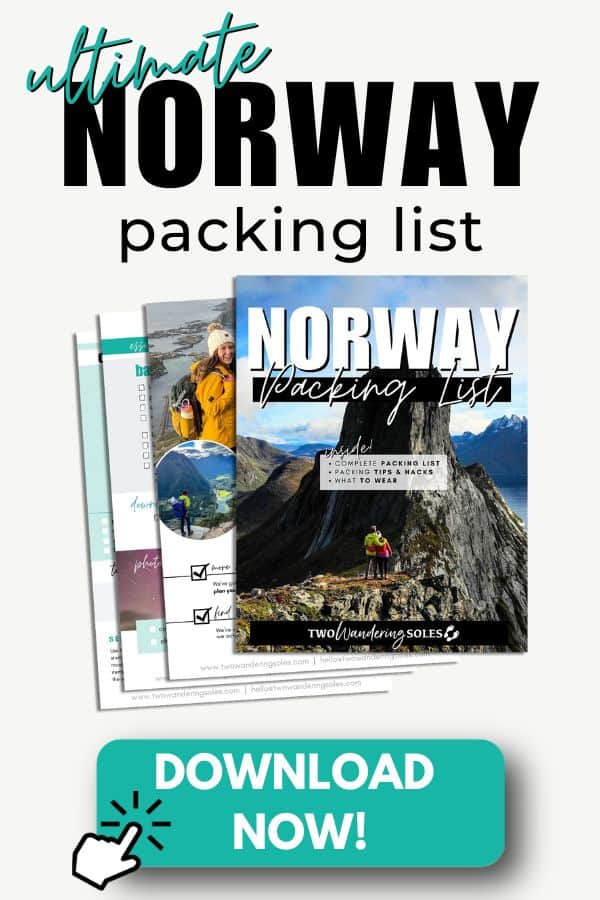We created the perfect 2 day Oslo itinerary that you can follow to see this city’s highlights as well as several hidden gems. We’ve packed this itinerary with tips on where to eat plus we’ve included some totally free activities.
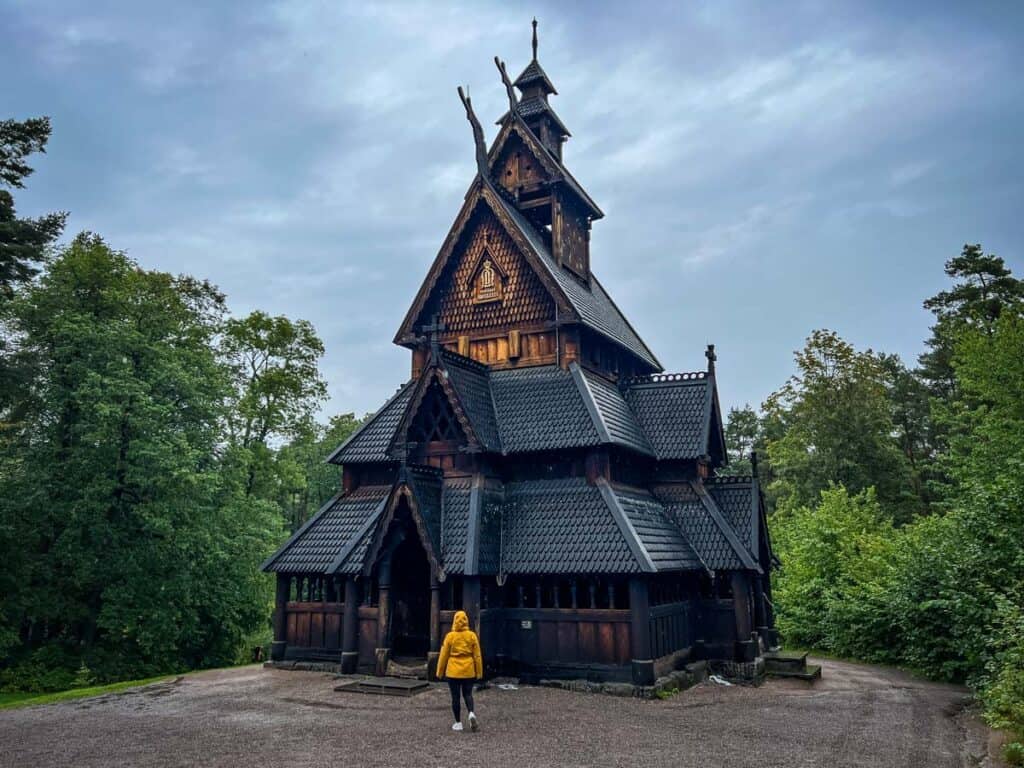
Located at the head of a fjord, Oslo has a blend of green space, historic architecture and museums, as well as a buzzy food and nightlife scene.
Norway’s capital city will likely be where you spend a couple of days at the start or end of your trip, and we’ve created what we think is the perfect way to spend 2 days in Oslo.
We have curated a 48-hour Oslo itinerary that hits some of the city’s top sights, but focuses heavily on hidden gems and budget-friendly activities.
Oslo Travel Guide
We’ve including some more info on planning your trip to Oslo. Jump to the following sections, or just keep scrolling to see it all!
- Our personal opinion
- Oslo itinerary overview
- Oslo Itinerary map
- How long do you need?
- Where to eat
- Where to stay
- Oslo Pass: Is it worth it?
- How to get around
Norway Packing List
If you’re planning a trip to Norway, we have the ultimate resource for you!
This FREE PDF download includes everything you’re going to want to pack for your trip to Norway, including what NOT to bring, plus tons of insider tips!
Sign up for our ultimate Norway packing list now and get a copy sent straight to your inbox.
Our personal opinion on Oslo
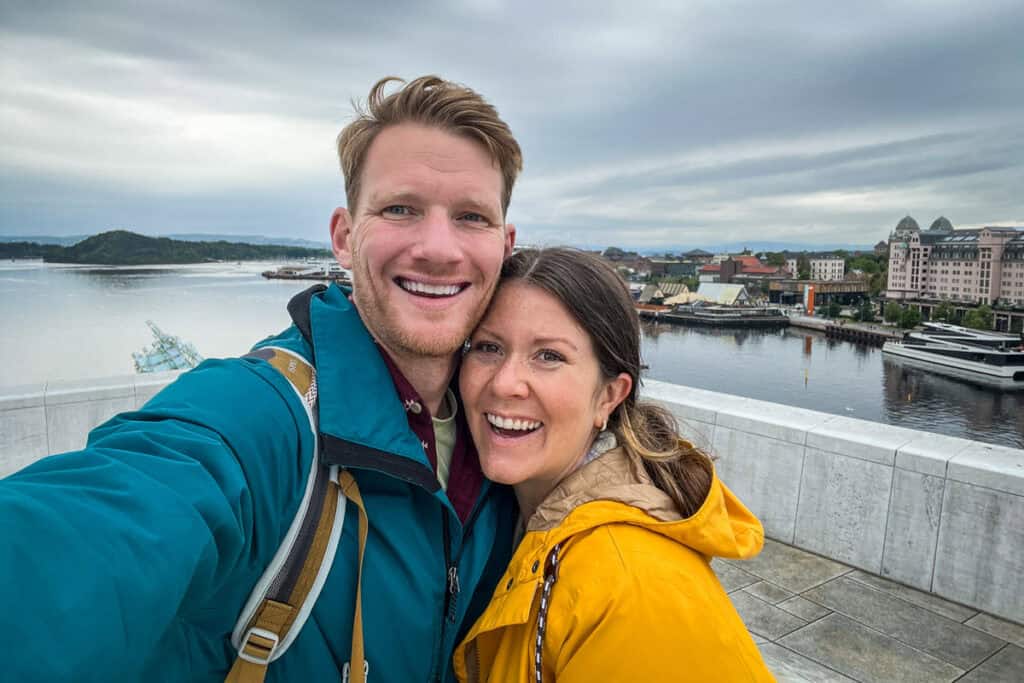
We liked Oslo more than we thought we would.
And that’s saying something because we had pretty crappy weather while we were there, so I’m sure we would have enjoyed it even more in the sunshine!
2 day Oslo itinerary overview
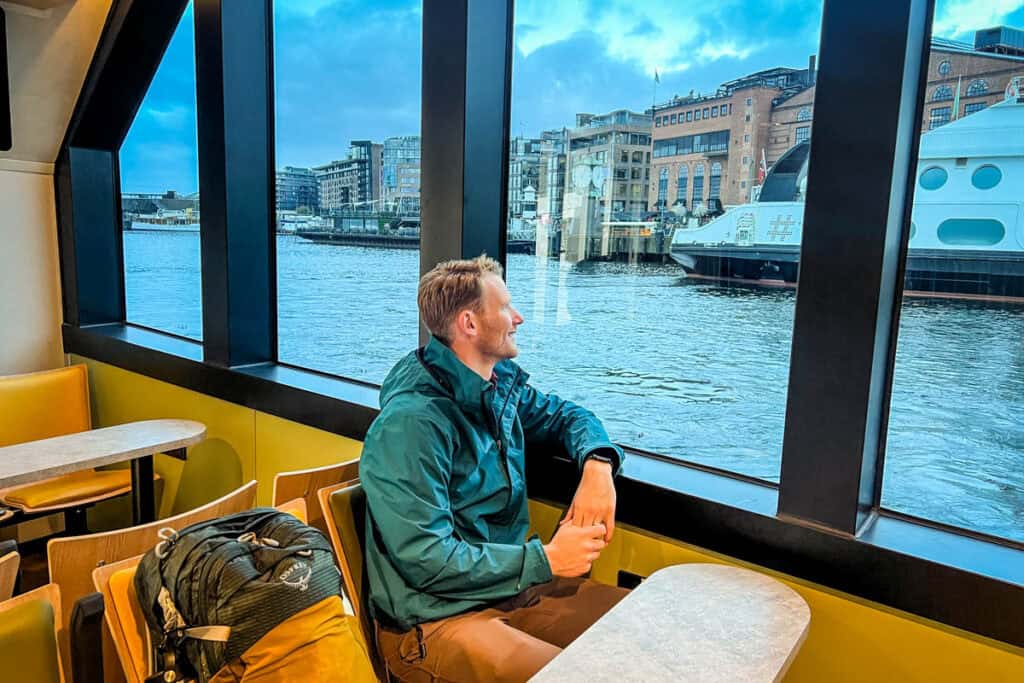
This itinerary is set up so that you arrive in the evening and are ready to explore the next day (aka day 1 on this itinerary). Plan to leave the morning of day 3, giving you a full 48 hours to explore Oslo.
That said, you can adjust the schedule to fit the time that you have there. For example, we picked up our campervan in the afternoon on Day 2, giving us just shy of 2 full days to explore.
Day 1
Day 2
Oslo itinerary map
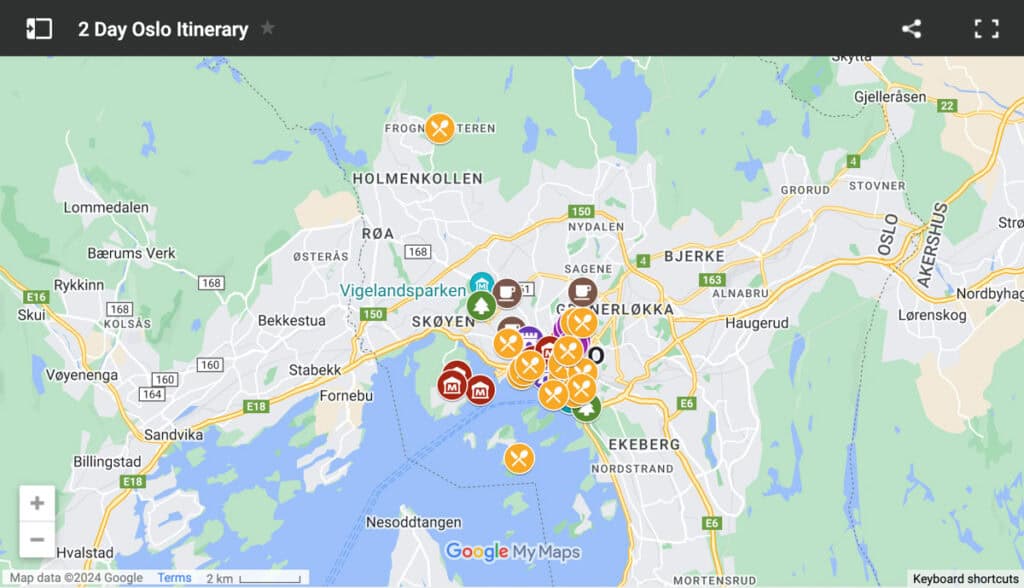
Click on the map above to go to the interactive version and have this 2-day Oslo itinerary at your fingertips.
Day 1
Today you’ll experience a combination of Norwegian culture, foodie experiences, and some of the iconic city sights.
1. Have breakfast at Bonita Cafe
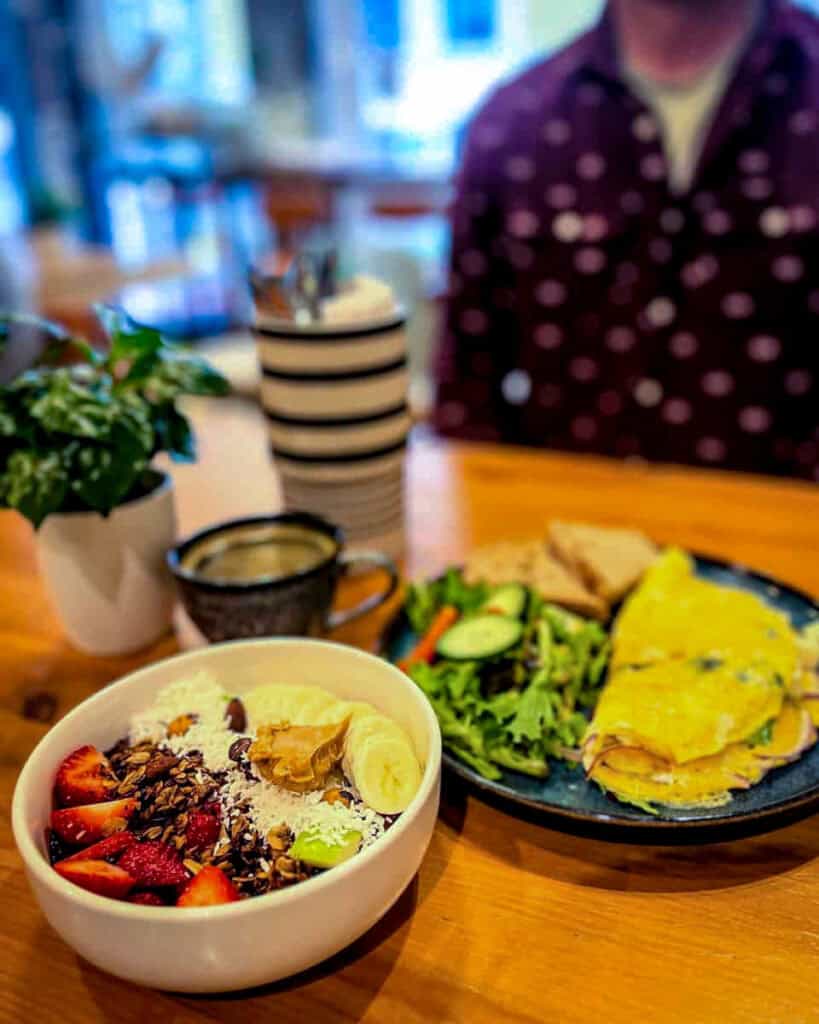
The cozy, pocket-sized Bonita Cafe is the perfect place to start off your trip with coffee and nourishment.
Their smoothie bowls and omelets are great, and the prices are in line with what you’ll find elsewhere in the city.
Our advice: There are plenty of coffee shops with pastries around the city, but we recommend having a larger breakfast today since lunch will be a bit later.
2. Visit a museum of your choice
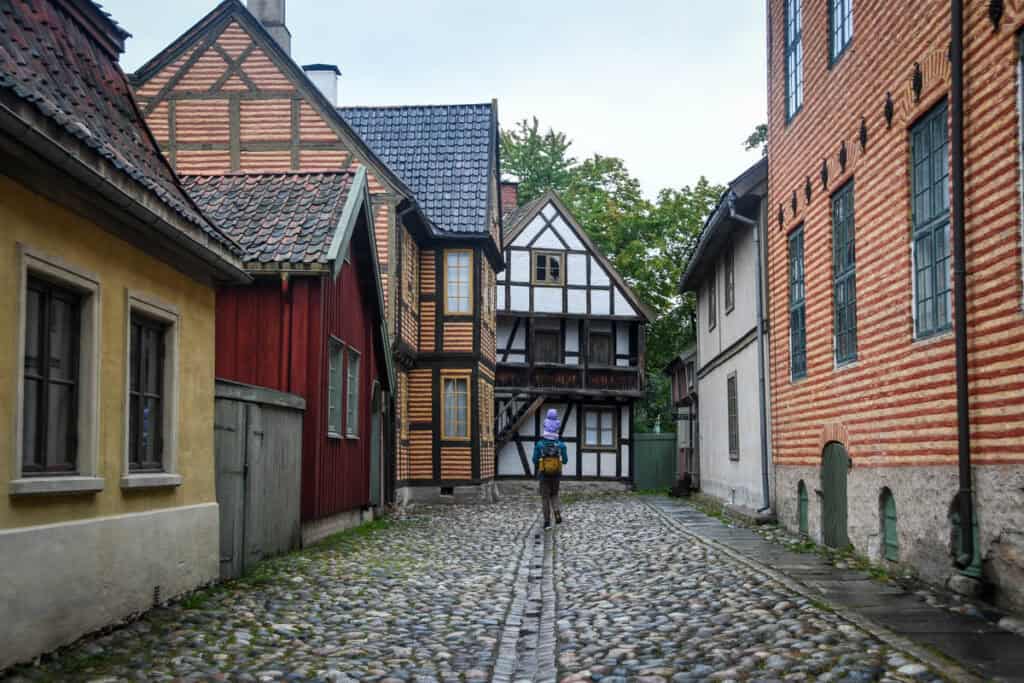
Oslo is absolutely packed with museums, so you’ll be spoiled for choice here. Even if you’re not a huge museum person (like us), we’d encourage you to visit at least one during your time in Oslo.
While there are museums all over the city, the Bygdøy peninsula (located just west of the city center), is home to some of the best museums in Oslo. You can get there easily via public transportation (either the subway or the bus).
Note on timing: Try to arrive at the museum of your choice right when they open so you can leave in time to grab lunch without being rushed. We spent about 2 hours and easily could have stayed longer.
Here are our top Oslo museum suggestions:
a) Norsk Folkmuseum (our pick!)
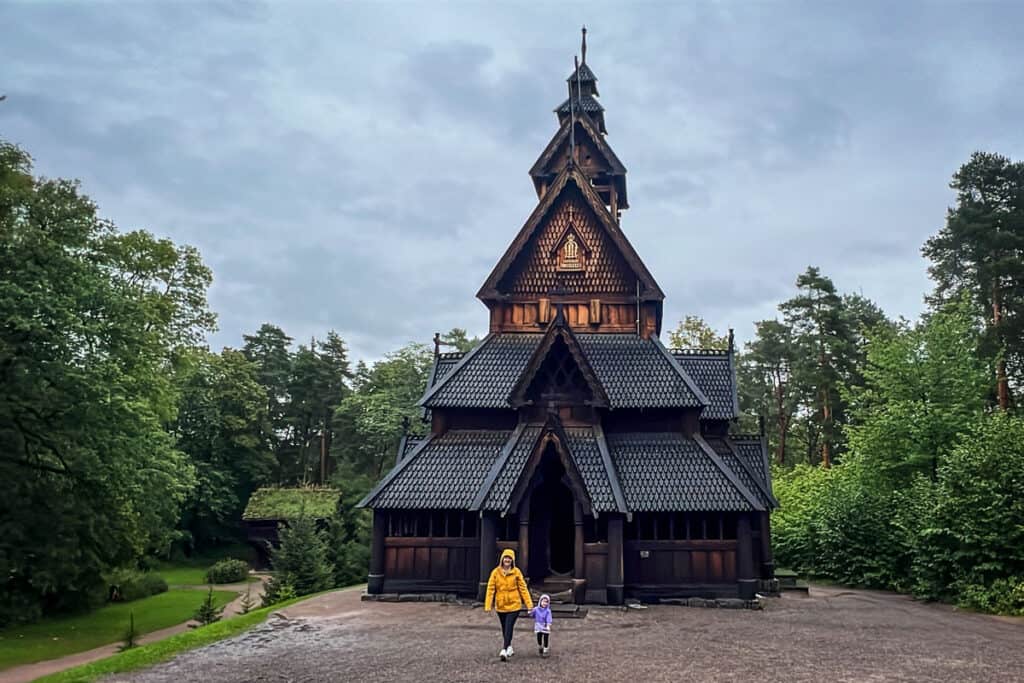
Also known as the Norwegian Museum of Cultural History, this collection of medieval buildings in an open-air setting feels more like you’re stepping back in time than exploring a museum exhibit.
Staff members dressed in traditional clothing are scattered throughout the grounds, really making these historic buildings come to life.
This is the museum we personally chose to visit, and we had a wonderful time. It was perfect for both adults and kids, and we liked that we felt immersed in the culture instead of spending time reading signs in front of glass enclosures.
- Hours:
- May – September: 10 a.m. – 5 p.m.
- October – April: 11 a.m. – 4 p.m.
- Admission: NOK 180 ($16.50) adults; children under 18 are free!
- Included with the Oslo Pass
- Google Maps location
- Museum website
b) The Fram Museum
This would likely be our second choice for museums to visit in Oslo. The A-frame architecture and waterfront property make for a picturesque setting, and it just gets cooler on the inside…
The Fram Museum is named after the first ship built in Norway for the purpose of polar exploration. Now, the Fram herself is housed in the museum. Not only is it impressive to see, but you can actually board the ship and explore some of the cabins and the engine room.
The museum also houses the Gjøa, the first ship to make the Northwest Passage, and other interactive exhibits about polar exploration.
- Hours:
- May – September: 9:30 a.m. – 6 p.m.
- October – April: 10 a.m. – 5 p.m.
- Admission: NOK 140 ($13) adults; NOK 50 ($4.50) children
- Included with the Oslo Pass
- Google Maps location
- Museum website
c) Viking Ship Museum
This attraction is currently closed while it’s under construction, and it will reopen as the Viking Times Museum in 2027. If your trip to Norway will be after it reopens, we’ve heard this is an incredible experience.
Note: This itinerary only leaves room for one museum visit (because we feel there is much more to this city worth exploring!). However, feel free to swap one of our recommended activities for another museum or add another day in the city to spend more time in the museums.
3. Have lunch at an indoor market
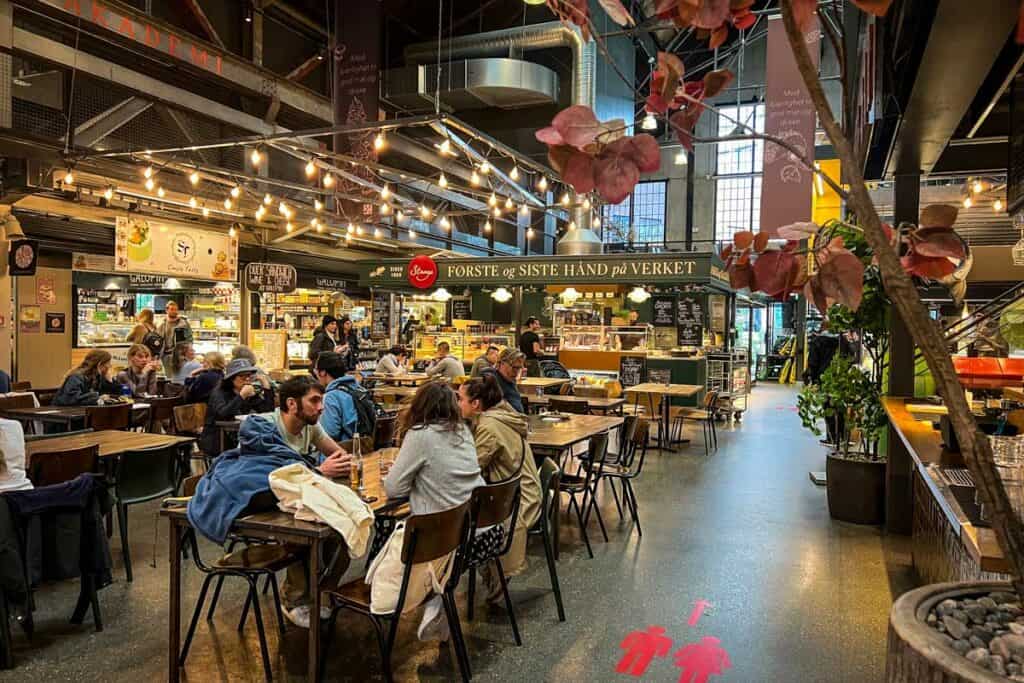
Once you’re done at the museum, it’s time to head to lunch.
We recommend jumping on a bus (see directions below) and heading to Mathallen, a large indoor market with many dining options featuring global cuisines.
Choose from street tacos, bao buns, wood-fired pizza, Korean-inspired corn dogs, burgers, and Pakistani comfort food, just to name a handful of options! (See all the shops and restaurants here.)
If you’re looking for Norwegian fare, we recommend Totally Wild, where the menu is focused on the “best ingredients from the forests and the mountains”. We split the reindeer stew (NOK 329 / $31) and it was really good, not to mention plenty of food for the two of us (plus our toddler, who had a bit as well).
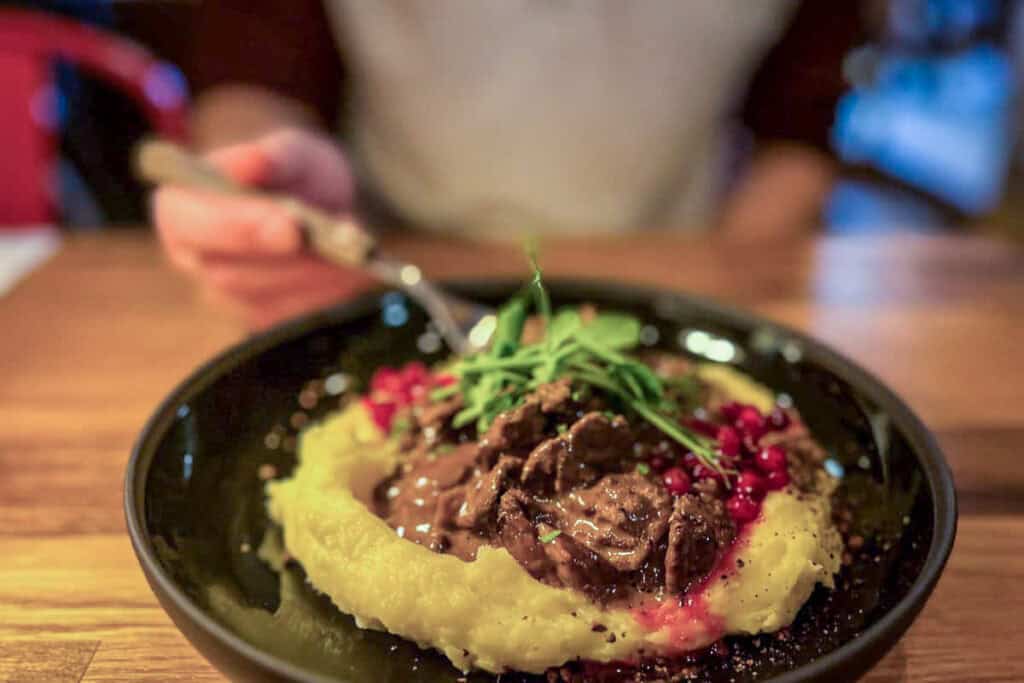
How to get there: Here are the directions to get from the Norsk Folkemuseum to Mathallen on a bus. It is roughly a 20-minute ride on the bus and then a 10-minute walk.
Alternative option for weekends only: If you’re on the Bygdøy Peninsula visiting a museum on a weekend, another lunch option is this cafe which is located inside a greenhouse. It is only open on weekends from 11:30 a.m. to 4:30 p.m. and looks incredible.
4. Riverwalk to a cute cafe
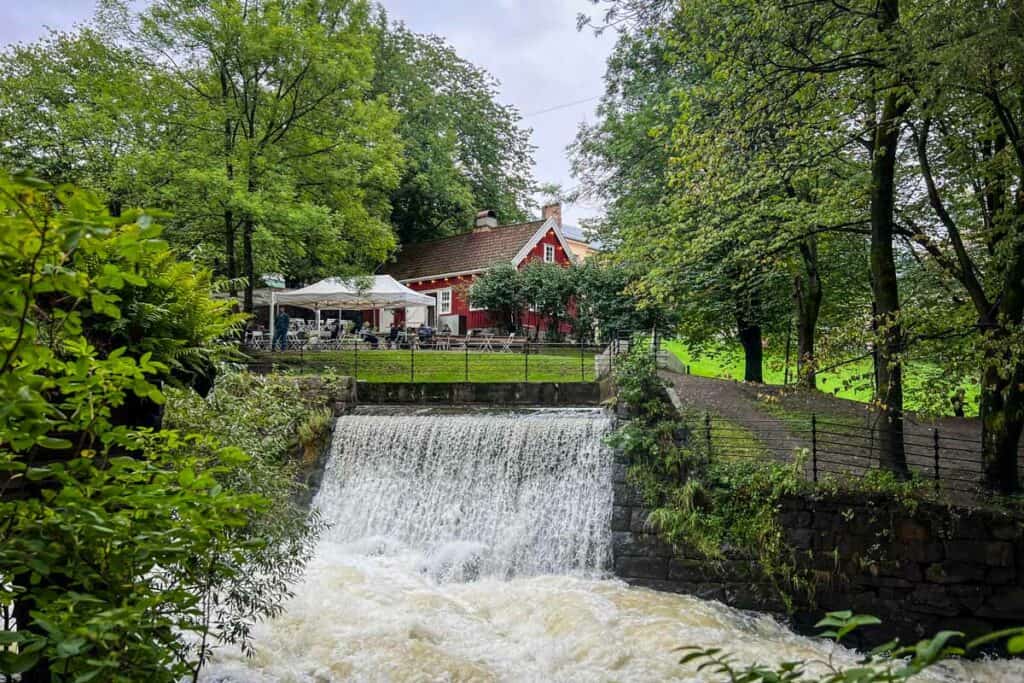
While you can get gelato and cupcakes at the market hall, we recommend saving your sweet tooth for this next stop.
From the market hall, you’ll walk roughly 20 minutes north on a trail that hugs the Akerselva River.
Short optional detour: To see a really atmospheric street, walk 5 minutes from the market hall to Damstredet, then continue on the river trail.
The trail is paved, mostly flat (though slightly uphill in places), and is a popular spot for locals to walk their dogs or go for a run. About midway through the trail, you’ll cross Aamodt Bru, which is a small but pretty suspension bridge that was built in the mid-1800s.
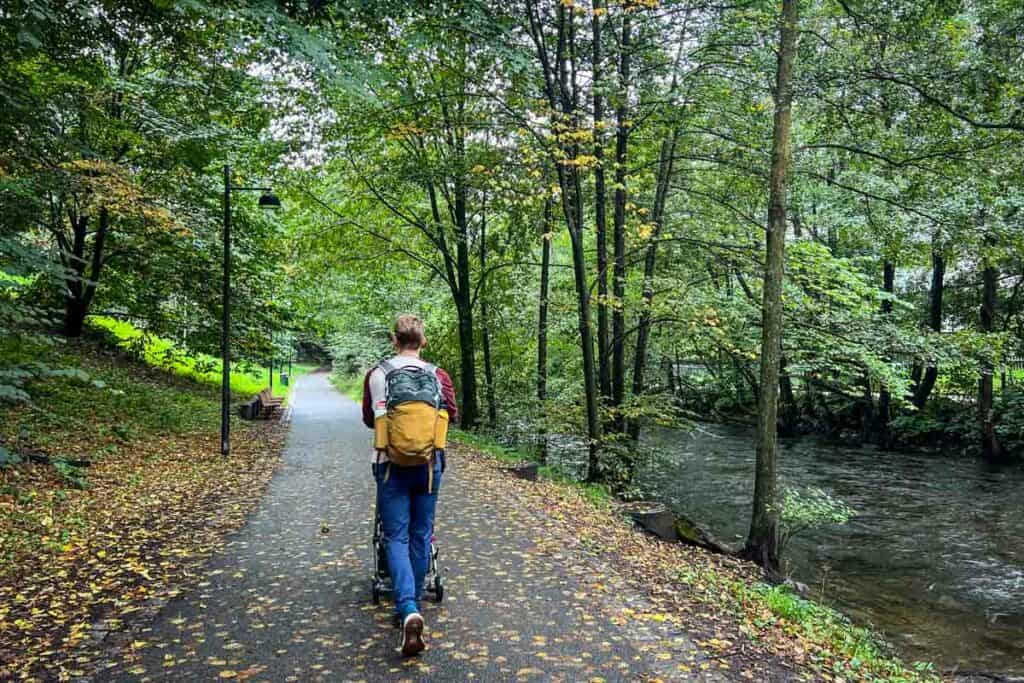
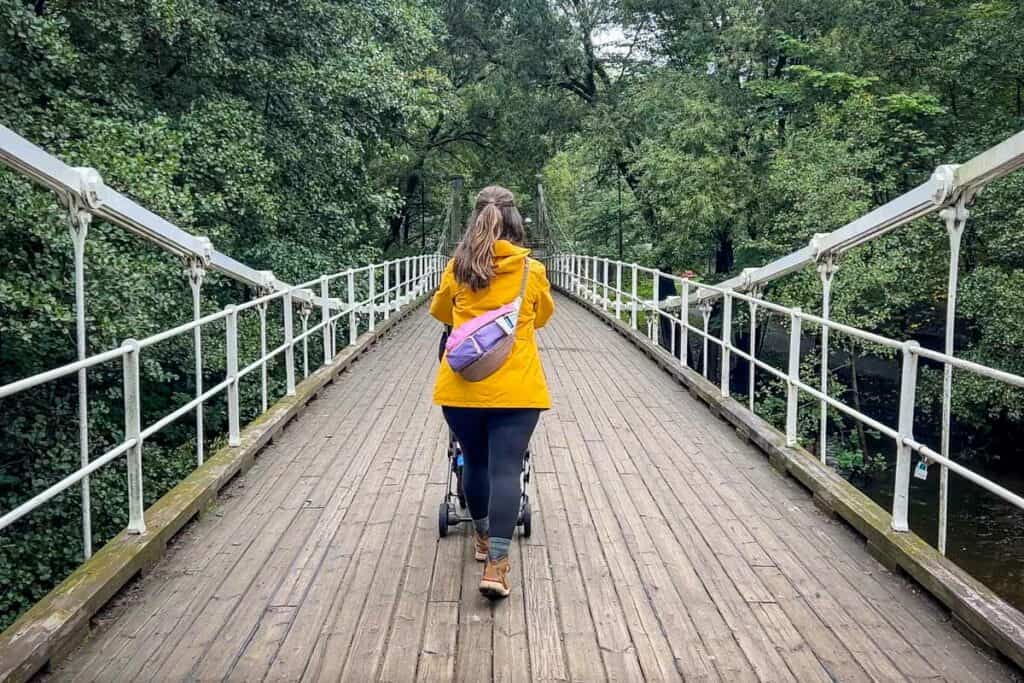
While the walk itself is nice, the destination is worth the journey! Once you reach a steep incline, you’ll know you’re almost there.
Perched at the top of a pretty massive waterfall, Hønse-Lovisas House is out of a storybook. Entering this charming cafe will make you feel as if you’ve been transported out of the city and are in the countryside.
This is a great place to try Norwegian waffles with jam and sour cream (you can add brunost, aka brown cheese, if you’d like). We also enjoyed the rhubarb crisp.

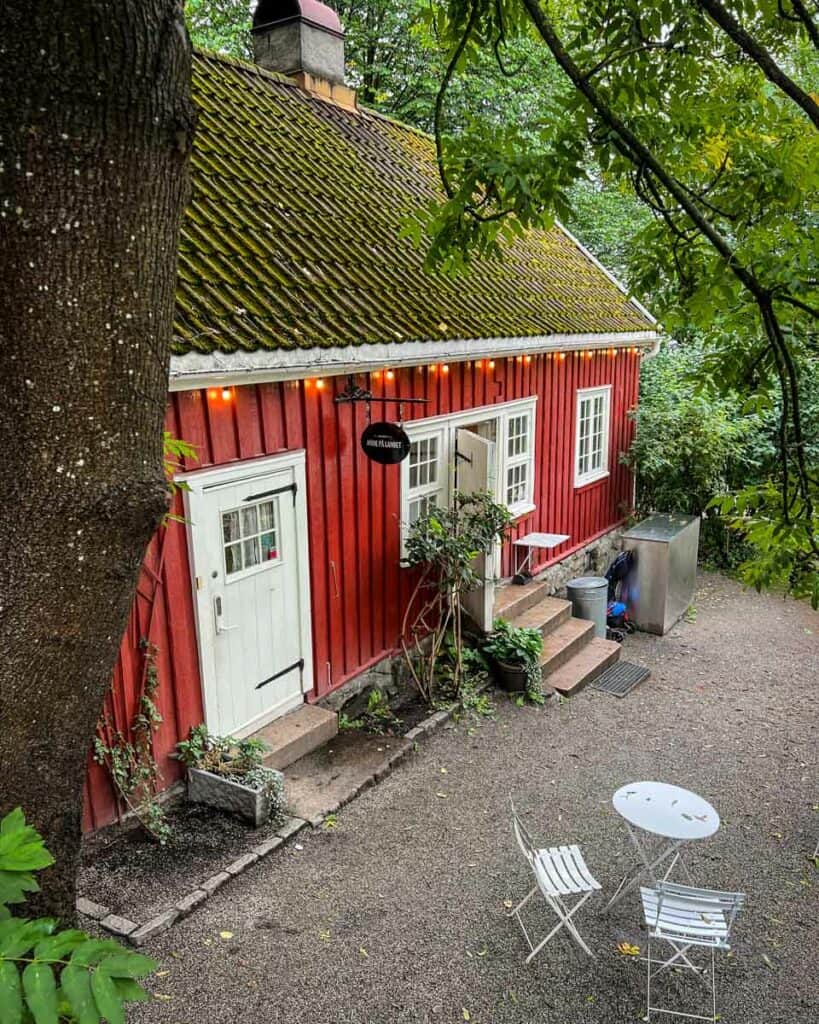
Take your time soaking in the peaceful atmosphere before heading into the lively center of the city for your next stop.
- Hours: Monday – Friday 11 a.m. – 4 p.m.; Saturday & Sunday 11 a.m. – 5 p.m.
- Google Maps location
Directions: When you’re ready, you can either gear up for a return walk along the river, or to save time, you can take the tram from the Hønse-Lovisas House to the center of the city. Here are directions.
5. Sightseeing at Karl Johans Gate walking street
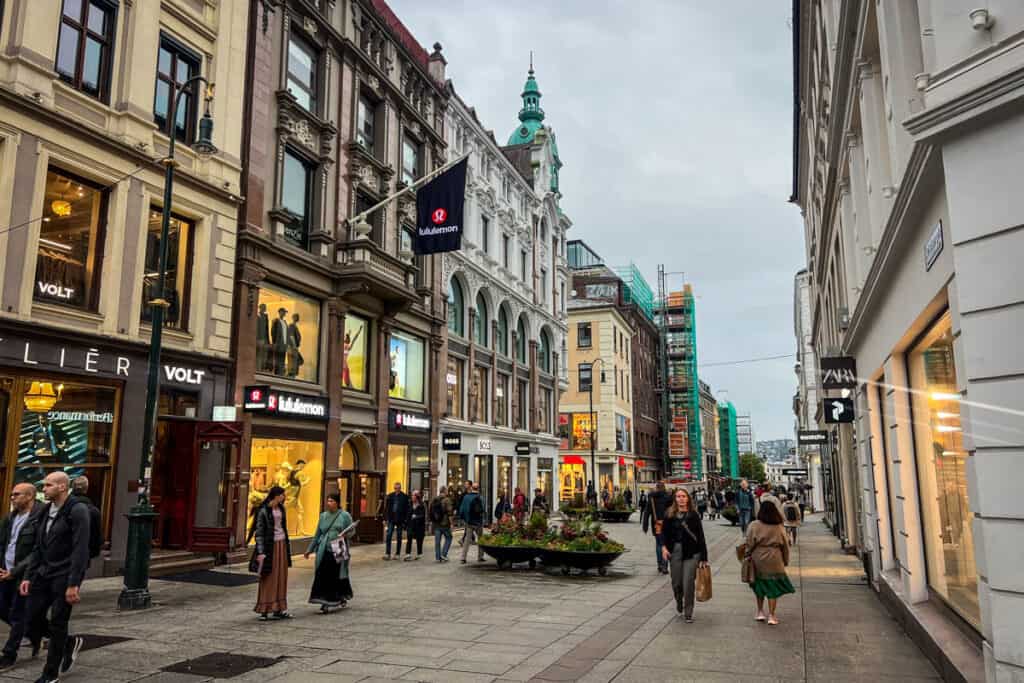
In stark contrast to the tranquil cafe you just visited, Karl Johans Gate is a popular pedestrian street that is typically crowded with both locals and tourists alike.
There are lots of big box stores, boutiques, and restaurants here, and it’s a great place to do a bit of people-watching.
If shopping isn’t your thing, there are a handful of landmarks along this street that are worth checking out:
a) Oslo Cathedral
If you’re interested, the Oslo Cathedral is also on this street. Built in the 1600s, this cathedral is not nearly as ornate as many Catholic churches you’ll find across Europe (Norway is primarily a Protestant country), but it is open to the public. You can visit free of charge from 10 a.m. – 4 p.m. every day except Friday, when it is only open at night.
b) The Tiger statue
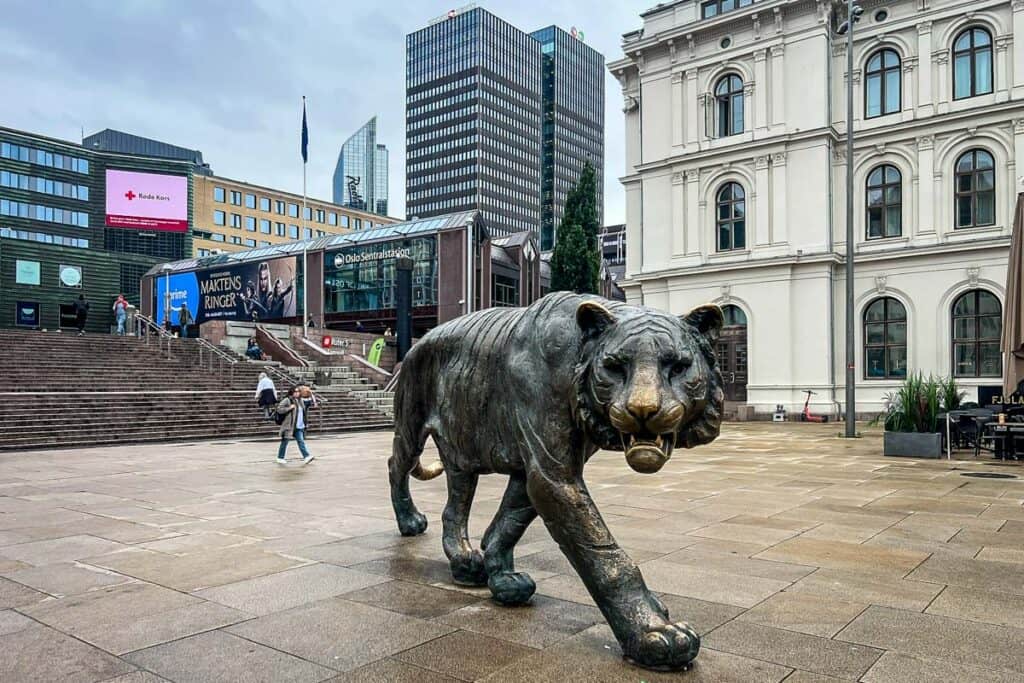
It’s hard to miss the bronze tiger statue in the square just outside Oslo Central Station. This is one of the most photographed attractions in the city, and while it might seem a bit out of place, there is a reason behind the tiger…
Story behind the tiger statue:
In 1870, Norwegian poet Bjørnstjerne Bjørnson wrote a famous poem “Sidste Sang” that described a fight between a horse and a tiger. The horse is said to represent the safety of the countryside whereas the tiger is a metaphor for the dangerous city.
This earned Oslo the nickname Tigerstaden or “The Tiger City”. Today, this is more of an homage to the city being lively and exciting, rather than dangerous. And in 2000, when Oslo celebrated its 1,000-year anniversary, a Norwegian artist created this tiger to celebrate the city’s colorful nickname.
c) Royal Palace
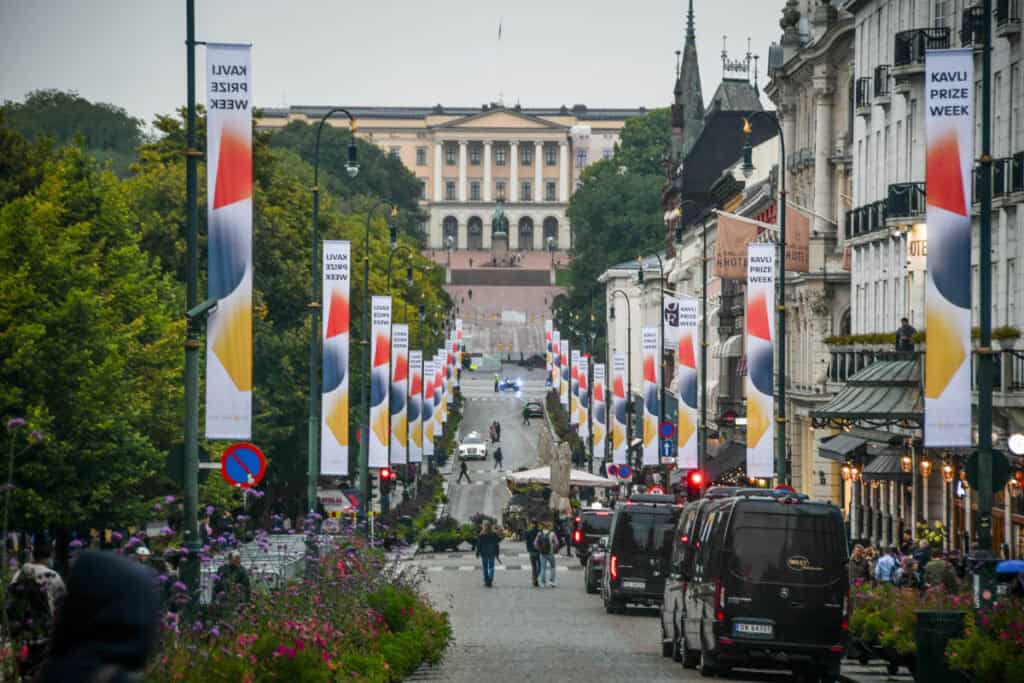
As you probably guessed from the name, the Royal Palace is the primary residence of the King and Queen of Norway. Again, it isn’t as ornate as Buckingham Palace. But unlike its London counterpart, Oslo’s Royal Palace is set in a public park, so the gardens are free to visit.
The changing of the guards also takes place in front of the palace daily at 1:30 p.m. and is pretty cool (and free!) to watch. In the summer months, you can also take a guided tour of some of the palace rooms.
6. See a comedy show with dinner
Latter makes a great pick for a unique dinner.
The venue is really cool and there are nightly comedy performances (with the exception of Sunday and Mondays).
While the comedy shows are the main draw, the food is also great, and features elevated dishes and pairing menus you wouldn’t expect from a comedy club.
- Hours:
- Tuesday – Thursday: 4:30 p.m. – 11 p.m.
- Friday: 4:30 p.m. – 1 a.m.
- Saturday: 4 p.m. – 1 a.m.
- Sunday & Monday: closed
- Google Maps location
- Good to know: Book your tickets and dinner reservations in advance
Alternative dinner options: If you’re looking for something with a different vibe, check out this list of places to eat in Oslo for more options.
Not ready to head to bed? Check out our suggestions for nightlife on Day 2 and hit up any spot that strikes your fancy!
Day 2
Today’s itinerary has a nice blend of the city’s most iconic sights as well as some really unique experiences that will likely be highlights of your time in Oslo.
1. Start your day with coffee at Pust
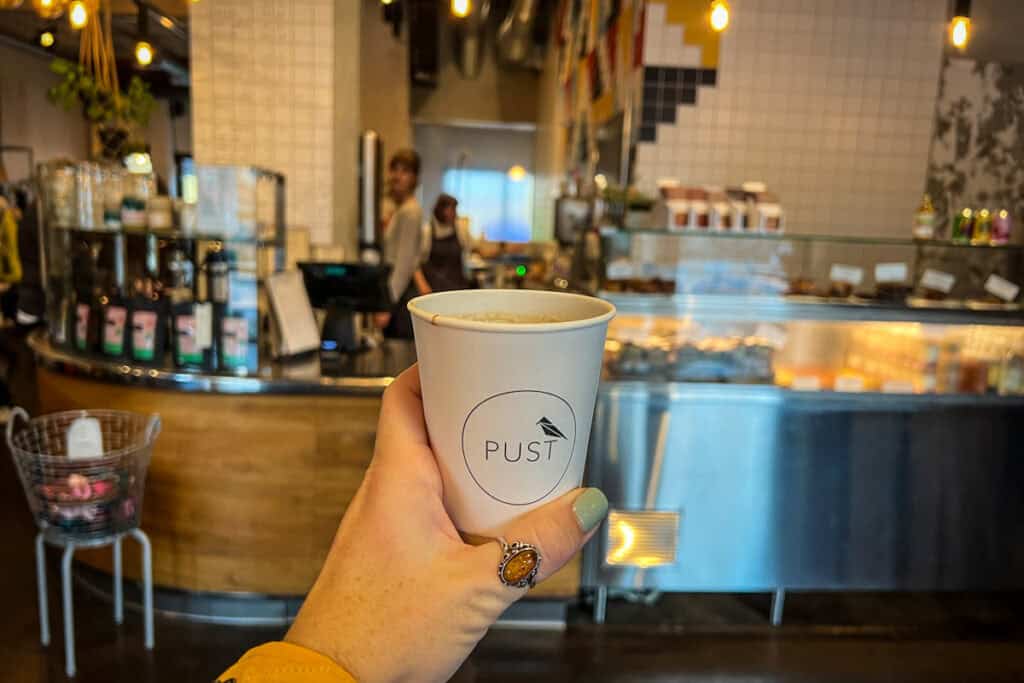
Start your day with coffee (and a pastry if you’d like). There are many excellent coffee shops around Oslo to choose from, but Pust is very close to your first stop this morning, making it a convenient pick.
- Hours: Monday – Friday 8 a.m. – 6 p.m.; Saturday & Sunday 10 a.m. – 5 p.m.
- Google Maps location
Enjoy your coffee inside or take it to go as you walk to the next stop…
2. Stroll Vigeland Statue Park
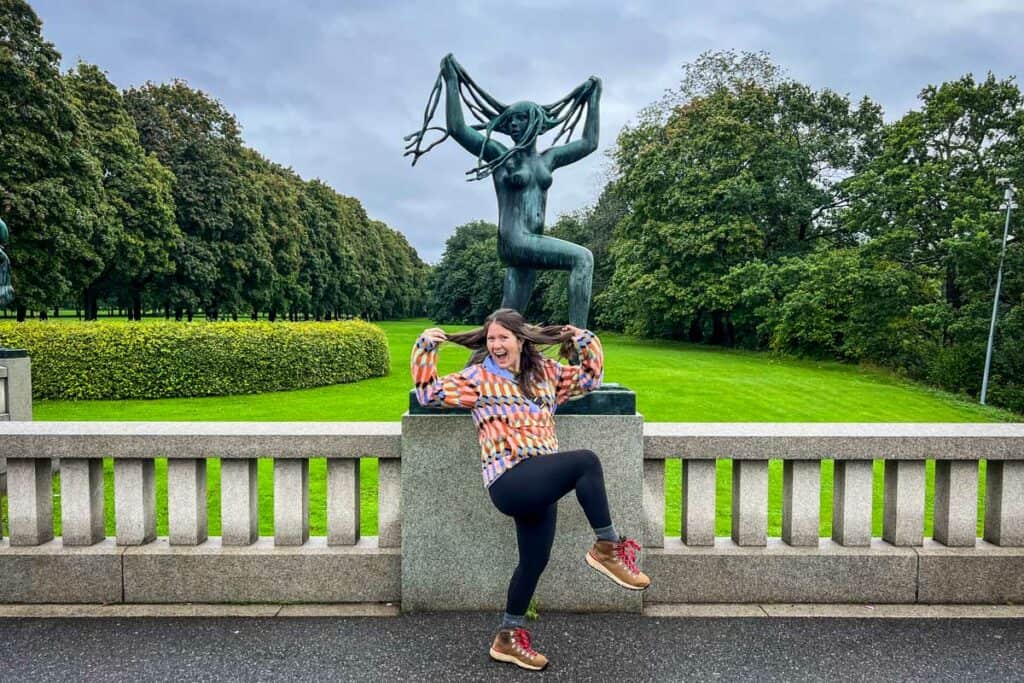
With a coffee in hand (or already in your system!), it’s time to explore Vigeland Park.
This quirky green space is most well-known for its statues, many of which are in… shall we say, interesting poses!
This is a popular spot for tour buses, so be aware that it can get busy. That said, it is a large space, so even if there are other people around it shouldn’t feel too crowded.
This is a fun park for taking photos and maybe even mimicking some of the poses yourself!
- Hours: open 24 hours
- Google Maps location
3. Go kayaking (for free!)
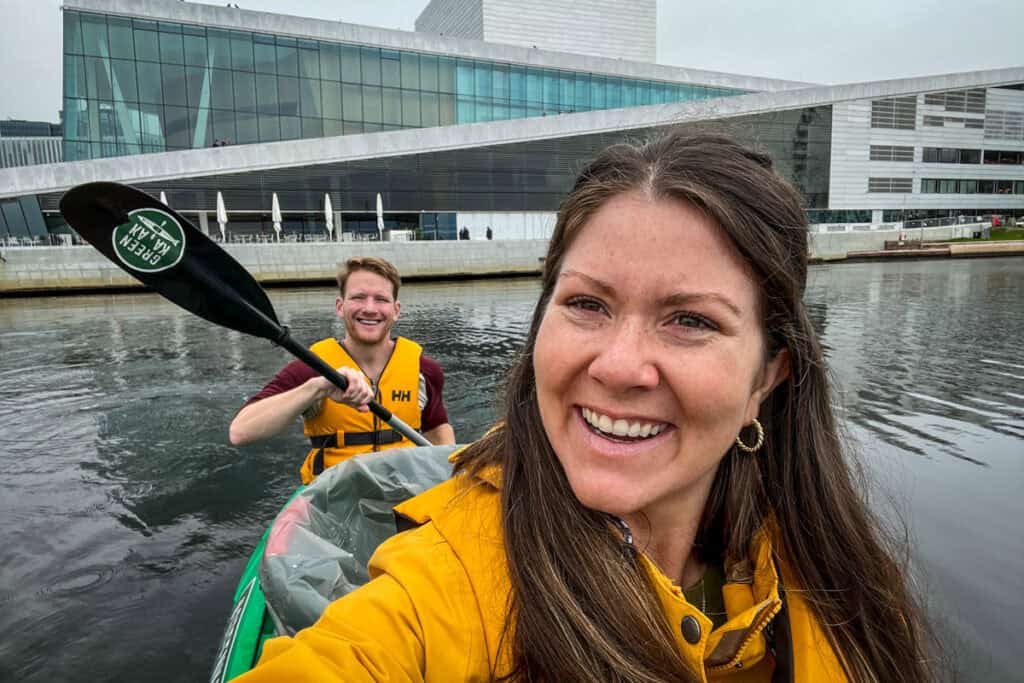
Did you know that you can rent a kayak in Oslo totally free of charge while doing something good for the environment?!
GreenKayak is an environmental NGO with a really cool mission:
You can rent a kayak free of charge in exchange for collecting trash you find in the water.
It’s a win-win because:
- You get to do an activity that is typically pretty expensive in Norway (kayaking!) for free in an iconic part of Oslo.
- Plus, you get to feel good knowing you’ve made a difference by helping clean up the environment.
Since 2017, GreenKayak has had tens of thousands of volunteers, and together they’ve collected far more than 100 tons of trash. How cool is that?!
In our opinion, this is one of the best free things to do in Oslo!
Things to know about booking a GreenKayak
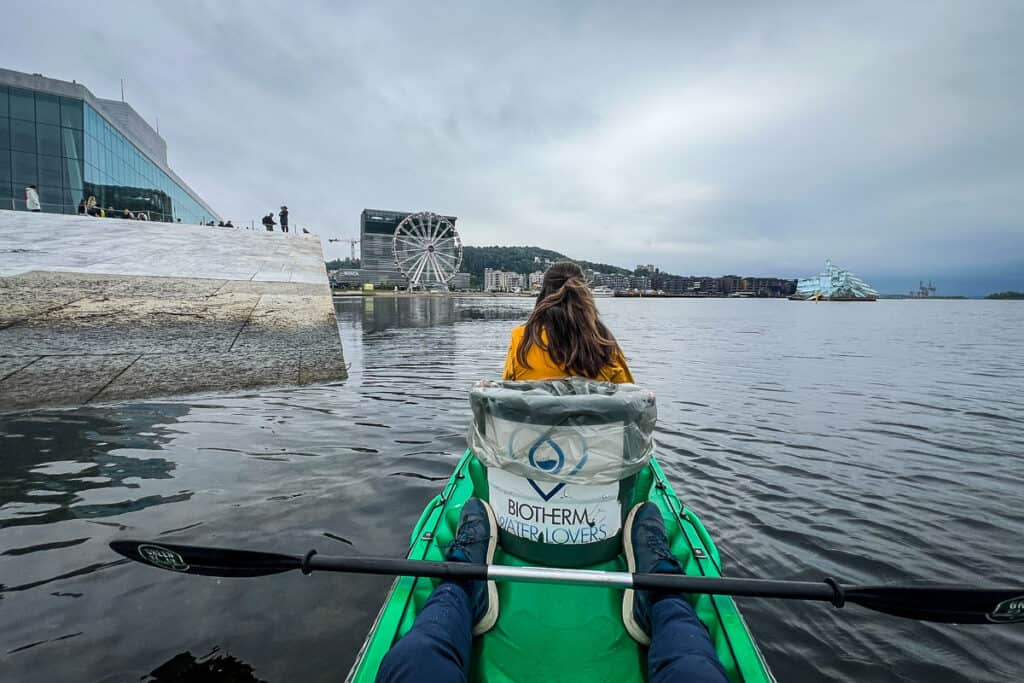
- It is expected that you share your experience on social media and use the hashtag #GreenKayak in order to spread awareness.
- It’s easiest to make a booking on GreenKayak’s free app.
- Time slots are 1 hour 45 minutes.
- If you’re following this itinerary, we recommend choosing the 10 a.m. time slot. Backwards-plan the rest of your morning so you get there on time.
- They are not open during the winter months due to cold water temperatures. The season typically starts at the beginning of May and you’re able to make bookings beginning in April.
- If you’re traveling with a small child, you may want to bring your own life jacket. We traveled in Norway with our toddler (2.5 years old at the time of the trip) and we packed her life jacket from home so we could do this experience, as well as kayaking in another area. We were glad we did, because neither place provided life jackets that would have been suitable for a small child.
- GreenKayak has locations in Norway, Germany, Denmark, Sweden, and Finland.
- Other locations in Norway include Bergen and Ålesund.
Our experience: When we took the kayak out, we didn’t find all that much trash, which I suppose is a good thing! That said, we still had fun taking the kayak out (for free!) in a super iconic part of Oslo and highly recommend this activity.
Alternative activity: If you’re not interested in kayaking, check out our list of more things to do in Oslo. Now could be a good time to do one of the nearby floating saunas. You could also visit a museum, or simply continue on with this itinerary.
4. Cruise Oslofjord on a local ferry
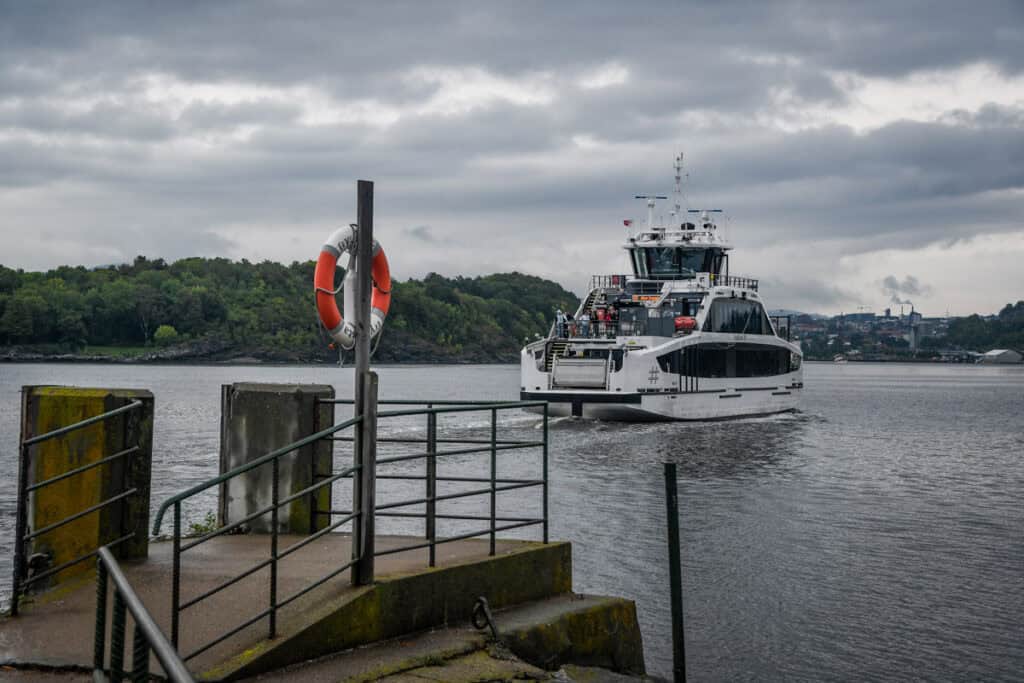
Here’s a budget hack a lot of travelers don’t know about… Fjord cruises are a popular tour, but you can experience the beautiful Oslofjord for a fraction of the cost by taking the local ferry.
It is a perfect budget-friendly Oslo day trip, especially on a nice day when you can explore hiking trails, find historic ruins, relax at a beach, or dine at a restaurant near the water.
There are six islands in the Oslofjord bay that are accessible by ferry:
- Gressholmen: Heggholmen lighthouse, swimming spots, hiking trails, seasonal restaurant (see below for more info)
- Lindøya: home to 300 colorful summer cabins, this island is really beautiful and peaceful to stroll around
- Hovedøya: closest island to the city featuring beaches, former military facilities (including 2 cannon batteries), monastery ruins that date back to 1147
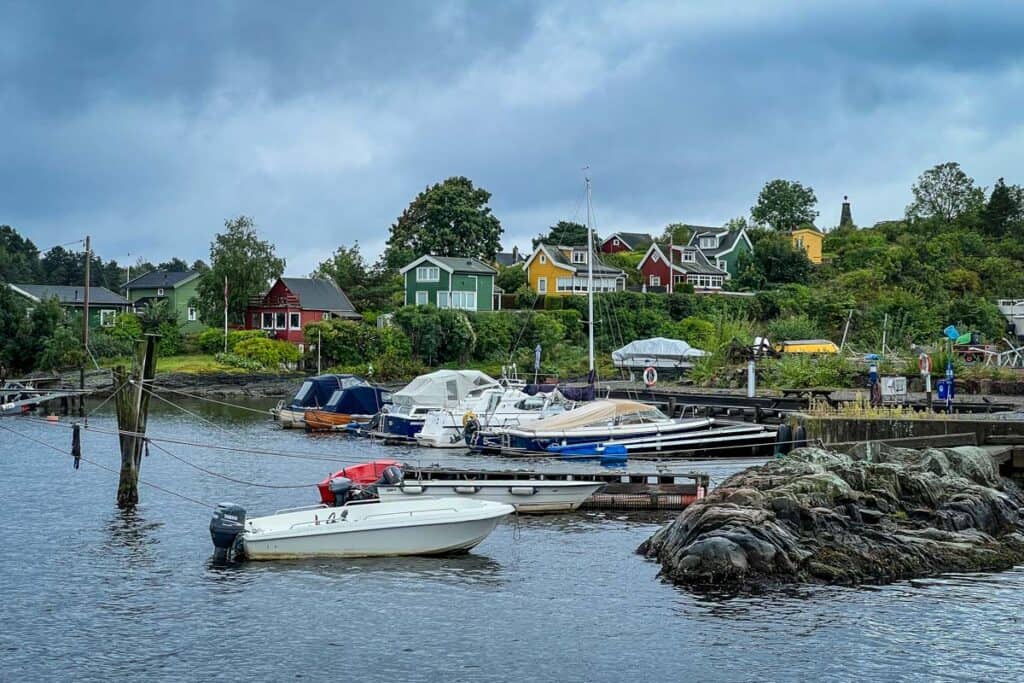
Bleikøya, Langøyene, Nakholmen are also accessible via the ferry, but there isn’t much to do or see on these islands, so we recommend sticking to one (or more) of the three listed above.
How to do it yourself: You can catch the ferries at this pier, located near the Aker Brygge wharf. There are signs overhead that tell you which islands each ferry will visit so you can be sure you get in the correct line. Find timetables for the ferries here.
Budget tip: If you have purchased a 24-hour public transportation ticket on Ruter (see more info here), the ferries are included and you do not need to pay anything extra.
5. Enjoy lunch on an island
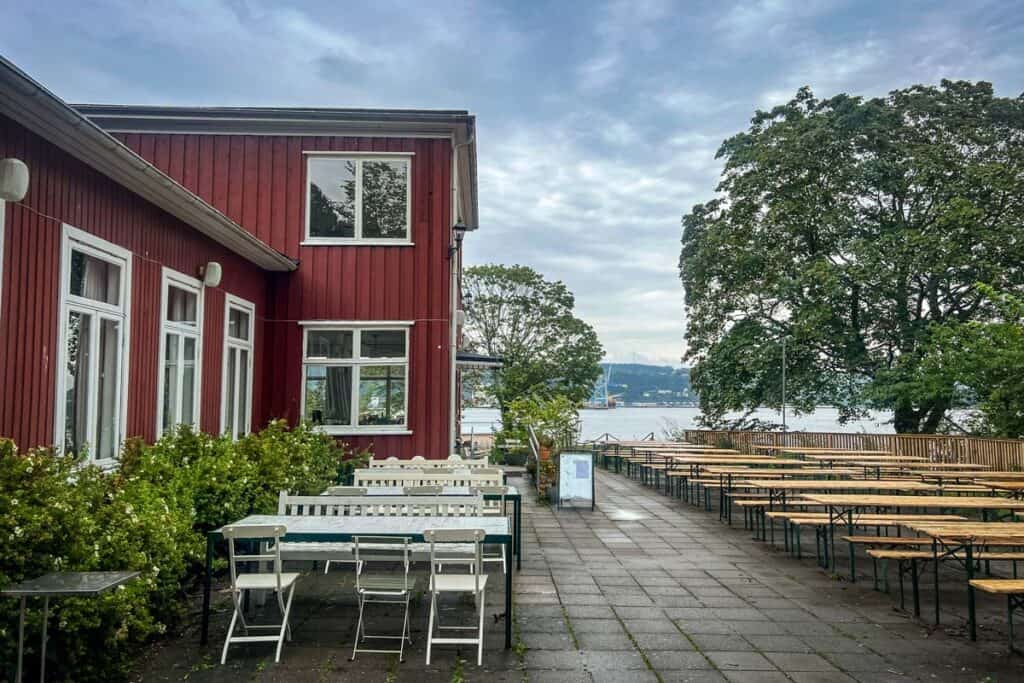
If you’re looking for a super unique lunch spot in Oslo (well, on an island near Oslo), this is it!
Gressholmen Kro is a seasonal restaurant located on the island of the same name. Its cheery red exterior and large patio area make it a perfect spot for enjoying seafood on a nice summer day.
Fun fact: Kro means “tavern” or “inn”.
Getting here is a bit of an adventure, but that’s part of the fun! Take the ferry that goes to Gressholmen Island. When you disembark the ferry, follow the trail through the woods with signs for the restaurant. It should take about 5 minutes to reach.
The menu is small and focuses on seafood, with dishes like a mussel bowl, fresh shrimp plate, and cold beer! There’s also a vegan option and some treats.
Alternative: If this restaurant isn’t open on the day you’re visiting, check our list of places to eat in Oslo for more options.
6. Walk the Harbor Promenade for the city’s most iconic sights
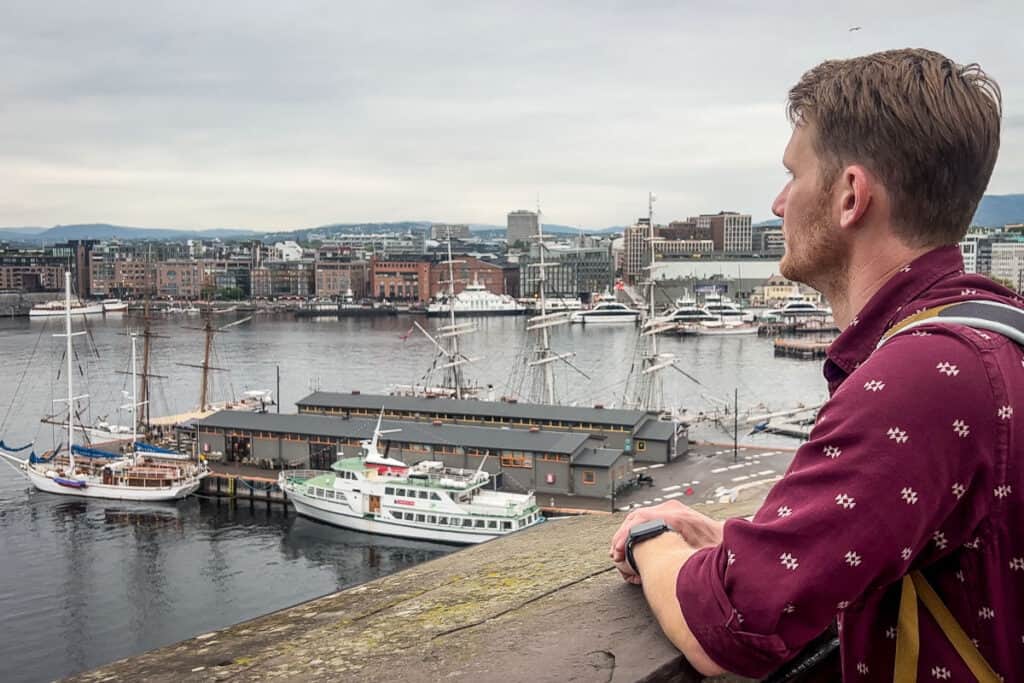
Spend your afternoon walking along the harbor promenade path, which will bring you to Oslo’s most famous landmarks.
Follow this walking route, which brings you to all the sights listed below and takes just over 1 hour to complete without stops. We recommend allowing yourself 2-3 hours total for this walking route, depending on how much you want to do and how many stops you plan to make.
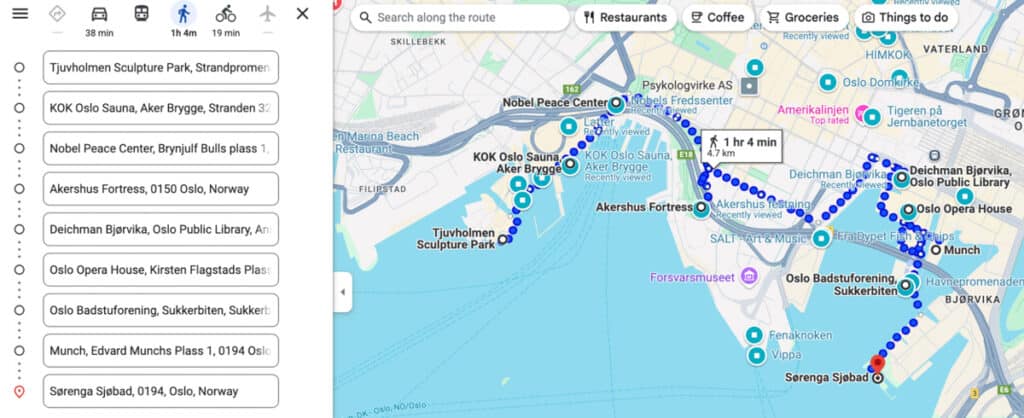
Note: You don’t need to stop at all of the locations listed, it is simply a general route to follow that passes by some of the city’s top attractions. Below, we’ve detailed some of the highlights.
Nobel Peace Center
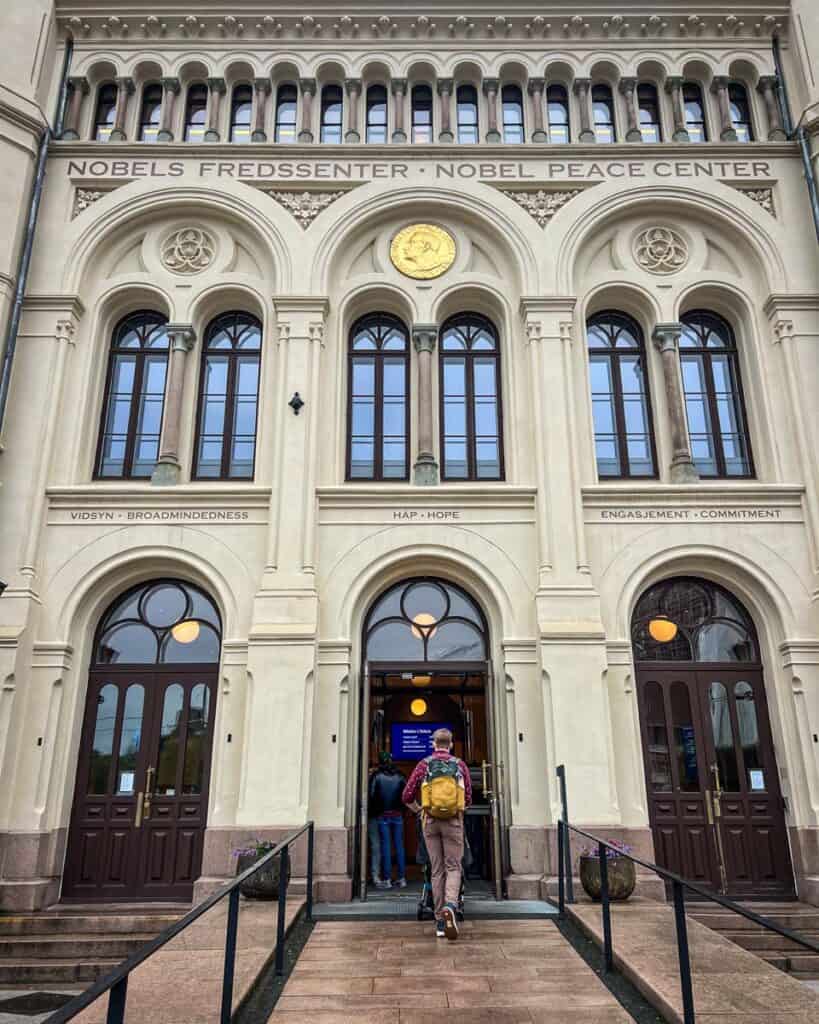
Housed in a renovated 19th-century train station, this museum features a variety of permanent and rotating exhibits inspired by Nobel Peace Prize winners’ works and ideas.
Well-known winners of the prize include individuals such as Malala Yousafzai, Barack Obama, Nelson Mandela, Mother Teresa, and Martin Luther King Jr., as well as organizations like Doctors Without Borders. But there are more than a century’s worth of laureates that most of us aren’t familiar with, each with their own inspiring story.
Our opinion: Unless this is something you’re really interested in, we think it’s only worth stopping here if you have the Oslo Pass. Otherwise, the entry fee is a little high and we personally think there are more memorable experiences to spend your money on.
- Hours: Tuesday – Sunday 11 a.m. – 5 p.m.; Wednesday 11 a.m. – 8 p.m.
- Admission: NOK 160 ($15) adult; NOK 100 ($9) children
- Included with the Oslo Pass
- Google Maps location
Akershus Fortress
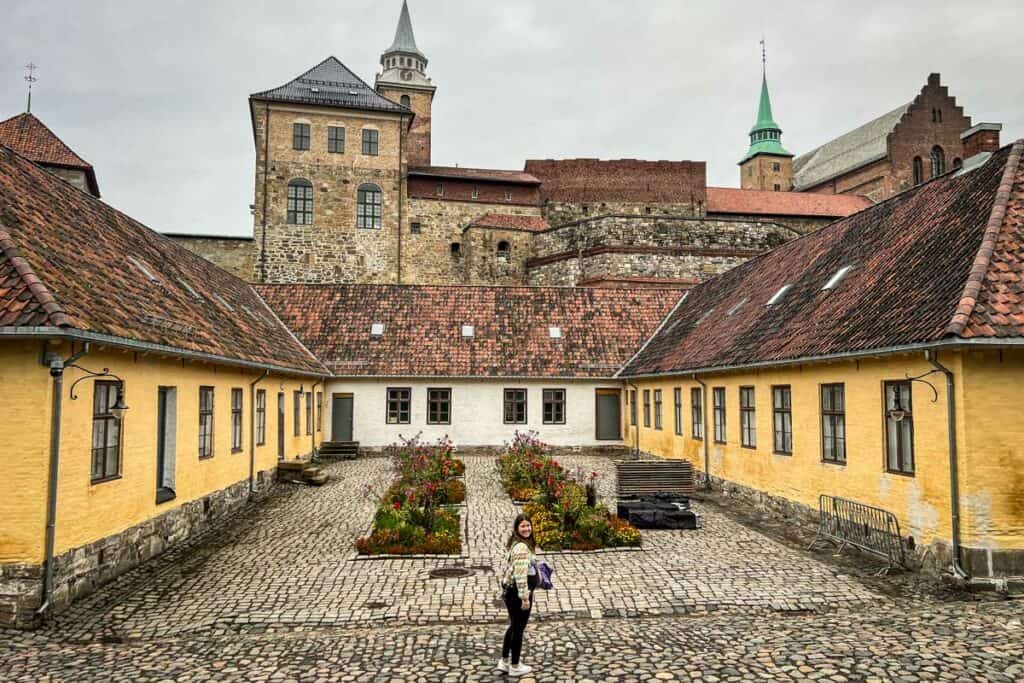
Originally built in the 13th century, this fortress is worth visiting, if only from the outside.
You can enter the grounds for free and see some great views of the fort, including some cannons, nice vistas of the waterfront, and this view of the Akershus Chapel, which was one of our personal favorites (pictured above).
- Hours: The main gate is open daily 6 a.m. – 9 p.m.; museums and visitor center have different hours which you can see here
- Admission: Free to enter the grounds, NOK 190 ($18) for entry to the onsite museums and the castle
- Akershus Castle and Armed Forces Museum included in the Oslo Pass
- Google Maps location
Oslo Public Library
The city’s public library is a stunning example of architecture and worth a wander, especially on a rainy day.
Not only are there cool art installations and design elements throughout the library, but there is a coffee shop, workshops, and activities for kids. There’s even a “maker’s space” with 3D printing machines, vinyl sticker printing, and more that can be used for free as long as you book a spot in advance.
Visit the library’s website to see events taking place and to book any machines you’d like to use.
- Hours: Monday – Friday 8 a.m. – 10 p.m.; Saturday & Sunday 10 a.m. – 6 p.m.
- Google Maps location
Oslo Opera House
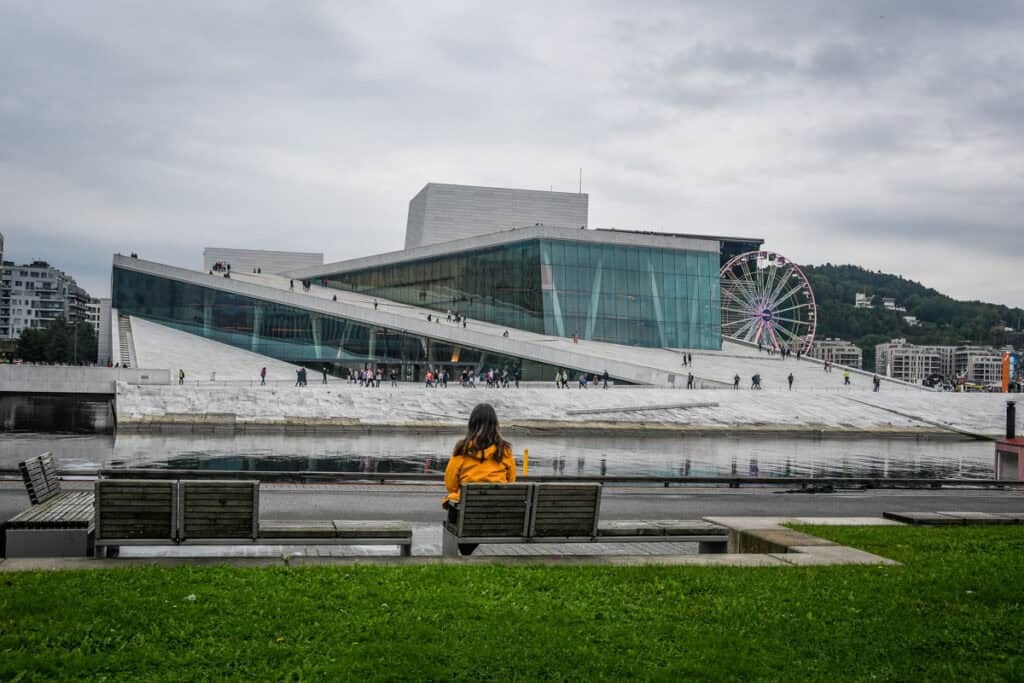
This is one of Oslo’s most iconic buildings, and while the opera and ballet performances are undoubtedly wonderful, the most popular thing to do at Oslo Opera House is to walk on top of the roof. That’s right, you can walk right up the slanted roof and get a great view over the city!
Munch Museum
This popular museum displays the work of the acclaimed Norwegian expressionist, Edvard Munch. The collection includes The Scream, without a doubt one of the world’s most famous works of art and most recognizable motifs.
Good to know: Edvard Munch produced multiple versions of The Scream. In order to limit their exposure to light for preservation, the museum rotates between 3 different versions: one in tempera and oil, one lithograph, and one in—believe it or not—crayon on cardboard. The museum doesn’t publicize the schedule, but you can call or email them to find out which version will be on display during your visit.
- Hours: Sunday – Tuesday 10 a.m. – 6 p.m.; Wednesday – Saturday 10 a.m. – 9 p.m.
- Admission: NOK 180 ($16.50) adults 25+; NOK 100 ($9) adults 18-24; children 17 and under are free
- Included with the Oslo Pass
- Insider tip: Admission is free every Wednesday night from 6 p.m. to 9 p.m.
- Google Maps location
Sørenga Saltwater Pool
If you’re visiting Oslo on a nice summer day, this urban dock is a cool place to stop as it is a popular local hangout for swimming and sunbathing.
7. Dinner & live music or global street food
For dinner tonight, you have two unique dining options to choose from.
The first is budget-friendly and more casual, while the second option requires advance booking and is a more elevated experience.
Option a) live music and casual food
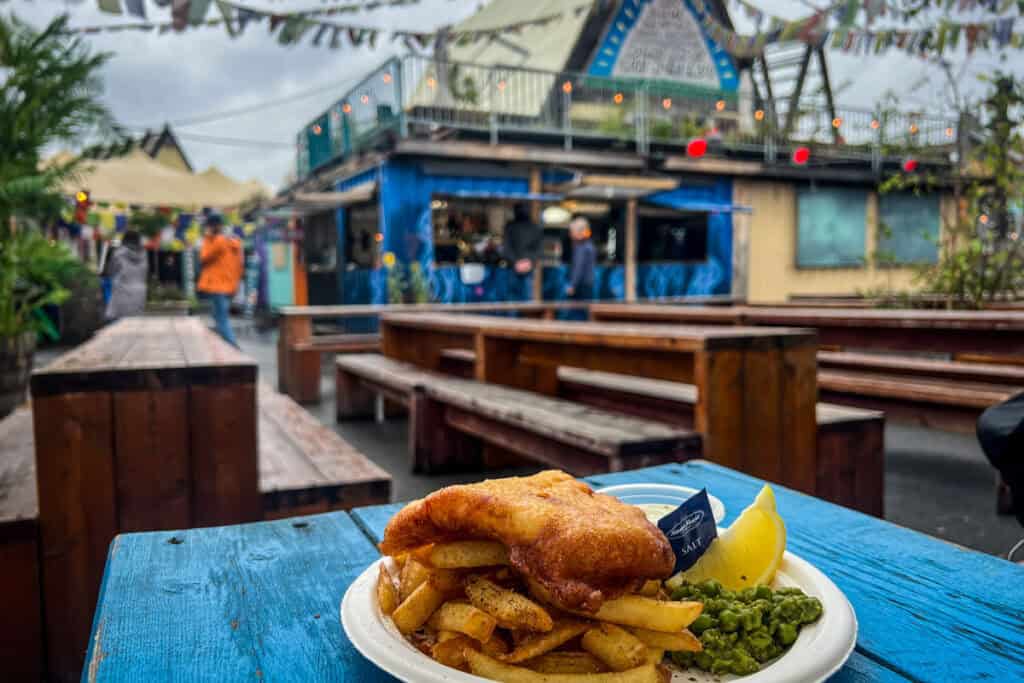
As you’re nearing the end of your walk along the Sorenga Waterfront path, make your way to SALT.
This buzzy venue hosts live music and has a handful of food cart options. We personally really enjoyed the fish & chips at Fra Dypet. It was super tasty and one of the most budget-friendly meals you can find in Oslo.
In addition to food, drinks, and music, SALT also has a unique sauna and fire pits, and hosts a variety of events. Check their schedule to see what’s going on during your visit.
- Hours: 11 a.m. – 10 p.m./11 p.m./midnight (depending on the day of the week)
- Google Maps location
Option b) street food market
Oslo Street Food is a popular foodcourt-style market with 4 bars and 16 food stalls offering different cuisines from around the world. You’ll have options such as tacos al pastor, poke, empanadas, and bibimbap, just to name a few.
The neoclassical building was once a public bathhouse, which gives the venue a unique character. On Friday and Saturday nights after the food stalls close, the tables disappear and the old swimming pool turns into a dancefloor with DJs spinning into the wee hours of the morning.
- Hours:
- Monday – Thursday 11 a.m. – 11 p.m.
- Friday – Saturday 11 a.m. – 3 a.m.
- Sunday 12 p.m. – 10 p.m.
- Food stalls close at 10 p.m. Monday – Saturday and 9 p.m. Sunday
- Book a table
- Google Maps location
Alternative dinner options: If you’re looking for something with a different vibe, check out this list of places to eat in Oslo for more options.
8. Experience Oslo’s nightlife
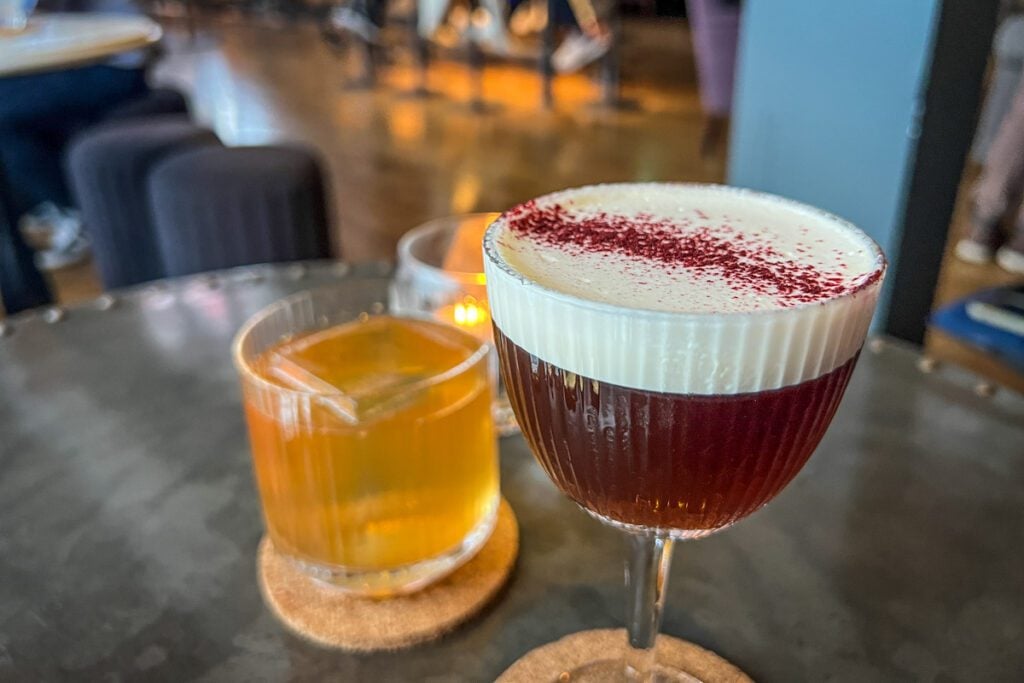
Oslo has a diverse nightlife scene, so there are plenty of options to choose from depending on the vibe you’re going for.
Craft beer in a casual setting? Check.
Hidden wine bar? Definitely.
Hand-crafted cocktails with speakeasy vibes? You know it!
There’s even a clubbing scene if that’s your thing.
Here are our top recommendations for grabbing a drink after dark:
- HIMKOK Storgata Destilleri (top rec!): With excellent cocktails and an atmosphere to match, it’s no wonder Himkok has earned a spot on the list of 50 Best Bars of the World.
- Crow Bar & Brewery: cozy brewpub with light bites and a variety of beers available in pints or tasting flights
- Nektar Vinbar: small, atmospheric wine bar with an elevated food menu
- Kulturhuset: Is it a cafe? A library? A concert venue? A nightclub? This 3-storey space is all of the above and more with multiple bars and a variety of events.
- House of Nerds: playful, gaming-inspired drinks in a fun setting with free access to board games and video game consoles
- Torggata Botaniske: intimate botanical themed cocktail bar
Put together a pub crawl of your own, or just choose the one that sounds most intriguing to you.
How long do you need in Oslo?
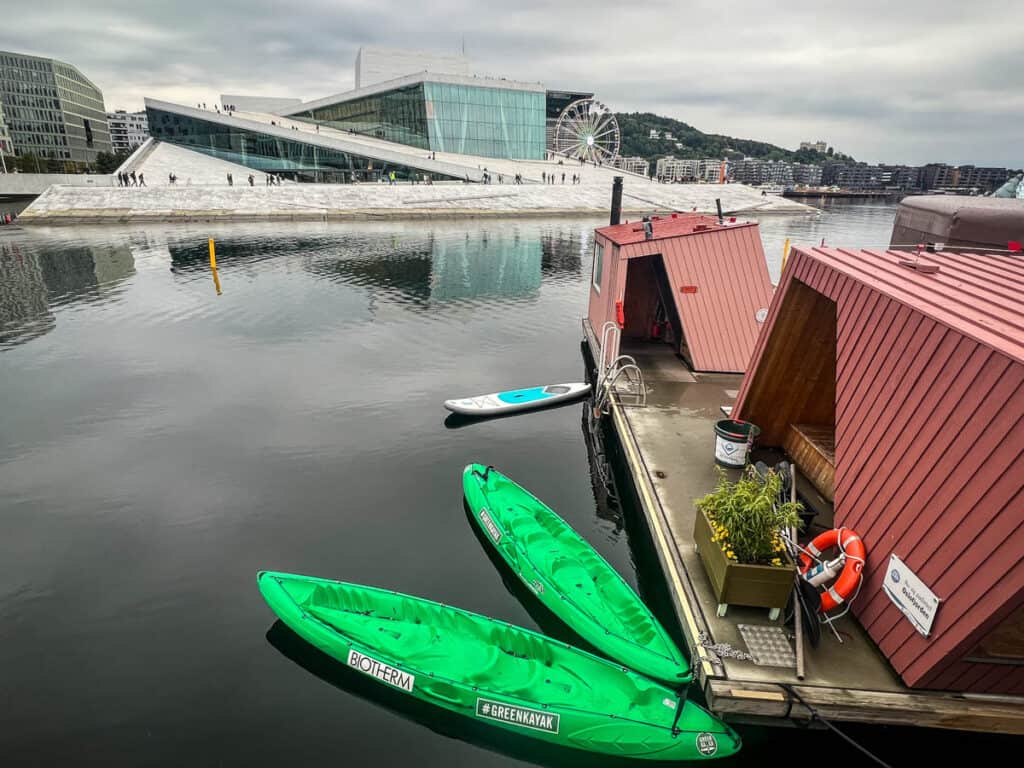
We think 2 days is a perfect amount of time to get a feel for the city and acclimate to the new time zone before embarking on an epic Norway road trip.
If you have more time, you could add an additional day for a total of 3 days in Oslo. Check out our list of more things to do to fill your time.
Our advice: Unless you have unlimited time on your trip, we’d recommend limiting your time in Oslo to 3 days because the spectacular countryside is what you come to Norway for, after all! You could truly spend a lifetime exploring Norway and still not see it all, so you’ll want to be sure to devote enough time to traveling outside of the city as that will likely be your favorite part of this trip.
Have more time in Oslo?
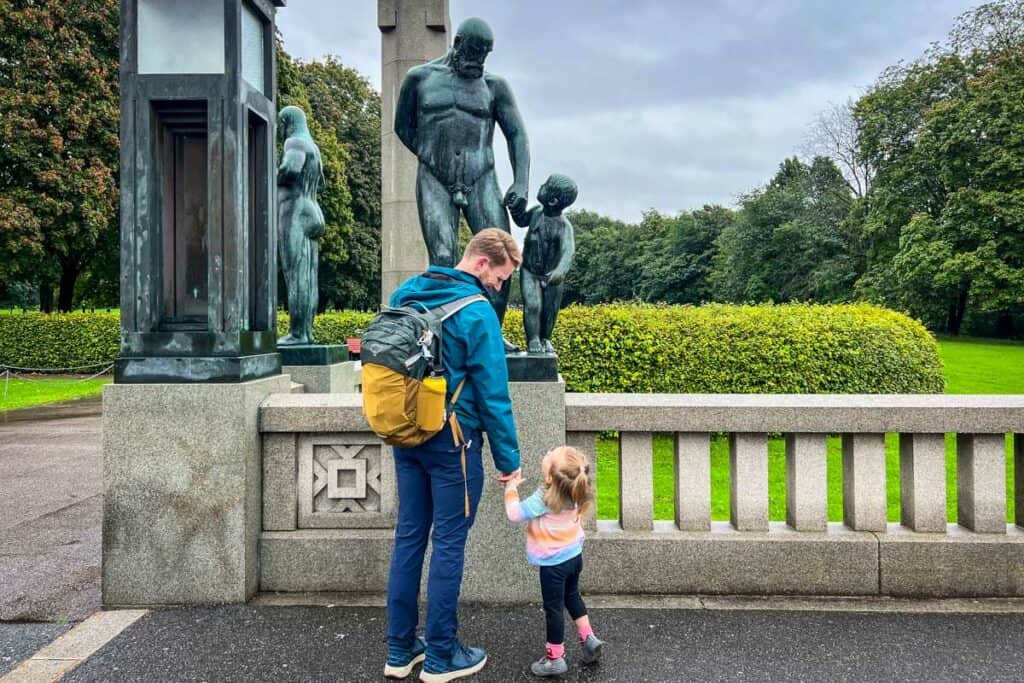
If you have more than 2 days in Oslo, here are some activities we recommend adding to your itinerary:
Learn about Norwegian cuisine on a food tour (our top rec!)
We’ve taken food tours all over the world and it is truly one of our favorite things to do on our travels.
This Oslo food tour looks incredible and receives rave reviews. A local guide (and her doggo!) will take you to hidden gems around the city where you’ll taste things like moose, reindeer, whale, and other Norwegian specialties.
Heat things up at a floating sauna
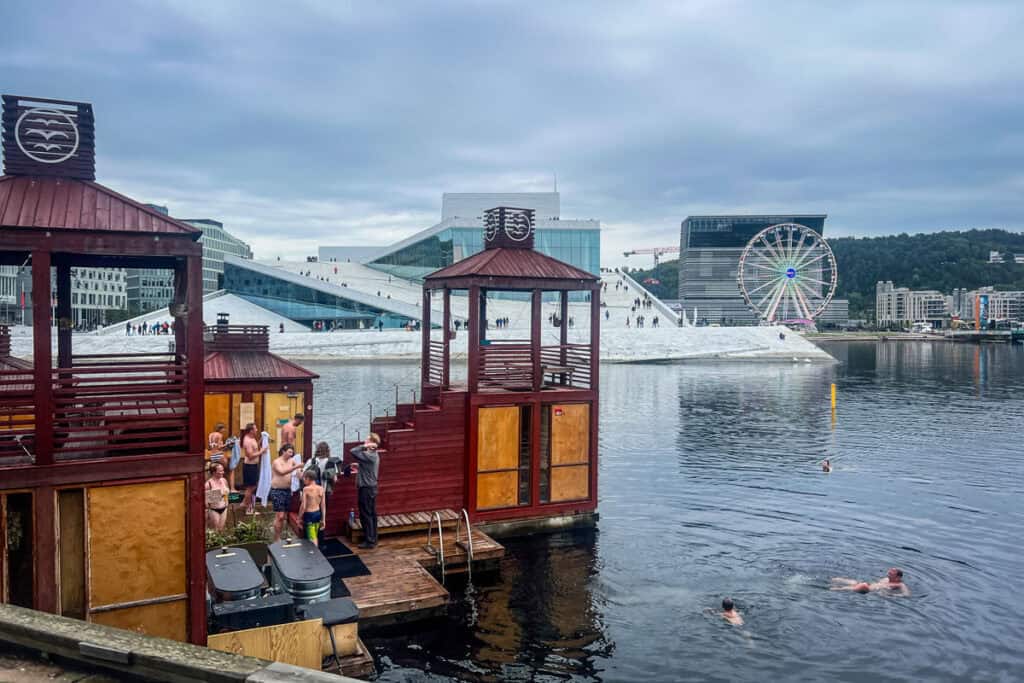
While traveling in Norway, you’ll definitely want to partake in sauna culture at least once (if not a bunch!). This floating sauna is conveniently located right in front of the Oslo Opera House, so it would be easy to fit into any itinerary. They offer both private and public saunas with iconic views of the fjord.
Visit more museums
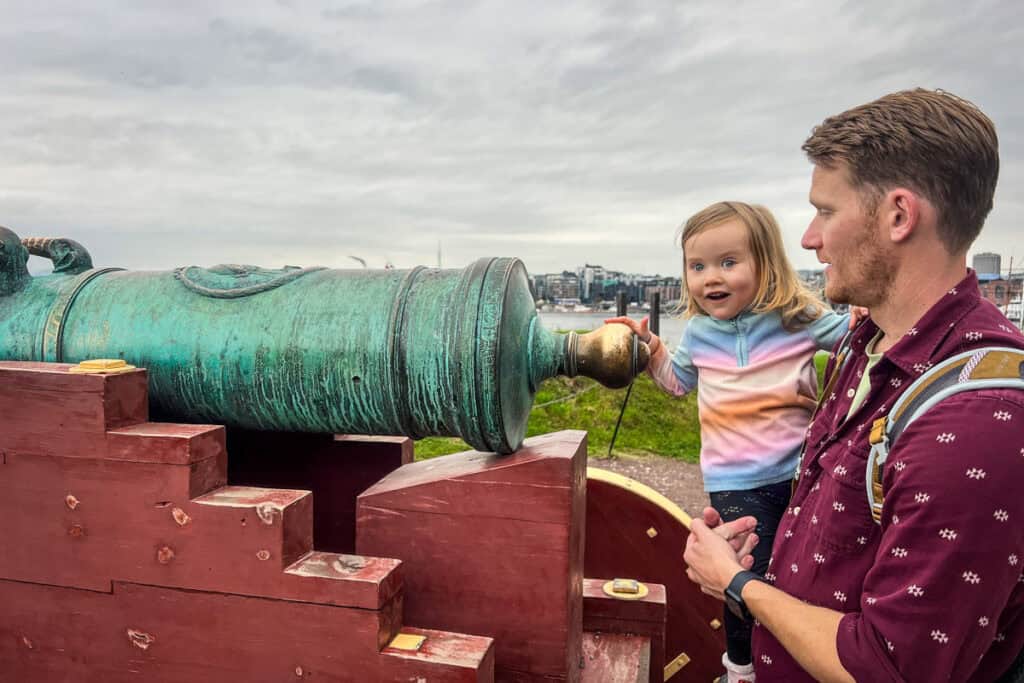
We’re not big museum people, so we chose just one to visit during our 48 hours in Oslo. But if museums are your thing or you have more time, you’ll have lots of options!
Here’s a recap of the museums we’ve covered in this itinerary:
- Norsk Folkmuseum
- The Fram Museum
- Viking Ship Museum (temporarily closed)
- Nobel Peace Center
- Akerhus Fortress
- Munch Museum
If you’re looking for something less traditional, check out the Paradox Museum. This family-friendly museum of optical illusions features 70 interactive exhibits and fun photo-ops. We’ve been to a couple of similar museums elsewhere and think this makes a great rainy day activity.
Go on a bike tour
For a fun outdoor activity that combines sightseeing with exercise (but the fun kind, where it doesn’t feel like work), this highly-rated bike tour could be a great choice. During the 3-hour tour, you’ll see lots of Oslo’s top sights and enjoy leisurely cycling on car-free bike paths. Plus, your guide will show you some local secrets most tourists don’t know about.
Wander the quirky Ekebergparken
This park just south of the Sørenga neighborhood could be a great place to stretch your legs on a nice day.
There are more than 40 art installations scattered throughout the park, including sculptures from renowned artists Dalí, Rodin, and Renoir, as well as modern works like the immersive Nordic Pixel Forest.
The location itself is also worthwhile, offering picturesque views of Oslo and the surrounding landscapes.
Have a meal at a restaurant overlooking Oslo
Perched on Holmenkollen around 1,500 feet above sea level, Frognerseteren offers fine dining in a historic log cabin with some of the best views of Oslo.
It’s easy to get to via public transportation, and the views from the train alone are supposedly worth the trip.
Insider tip: If you don’t have room in your budget for a full meal here (it’s pretty pricey!), head to the cafe for a slice of their famous apple cake.
Take a fjord cruise
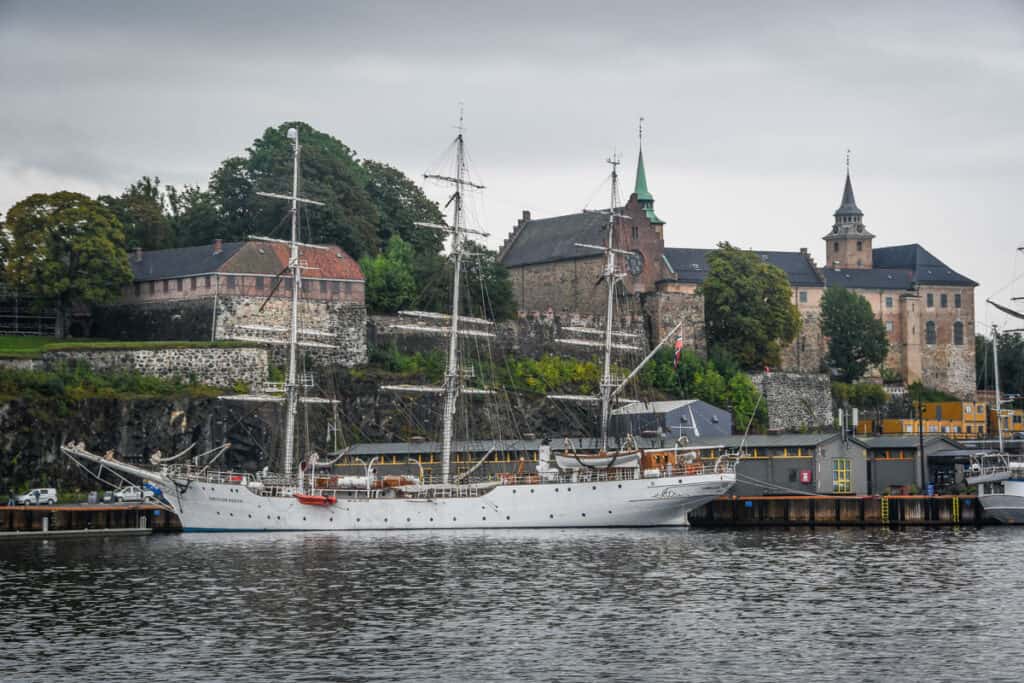
Cruising the Oslofjord is undoubtedly one of the top things to do in Norway’s capital city, and there are multiple companies and different types of boats to choose from. We’re sharing 2 tours that we’d recommend to help you narrow down your choices.
Budget travel hack: Want to take a boat cruise in Oslofjord for a fraction of the price of a tour company? Jump here for one of our hottest tips on saving money in Oslo!
Option a) Traditional sailing ship
Set sail down the fjord on a traditional sailing ship with the modern luxury of a heated deck, so you can stay cozy while enjoying outdoor seating with unobstructed views. This tour includes transportation to and from Bygdøy with 2.5 hours of free time to explore any of the peninsula’s famous museums.
Option b) Electric boat
On this sightseeing tour, you’ll pass iconic landmarks such as the Opera House and Akershus Fortress while your guide shares info on the local wildlife and natural environment.
Go kayaking on a hidden lake with a local
This highly-rated wilderness tour is perfect if you’re looking to get out of the city and away from the tourist crowds.
Join your local guide for a small-group kayaking trip on a secret lake that few tourists ever see. This tour also includes a picnic lunch cooked over an open fire along with tea, coffee, or hot chocolate.
Where to eat in Oslo
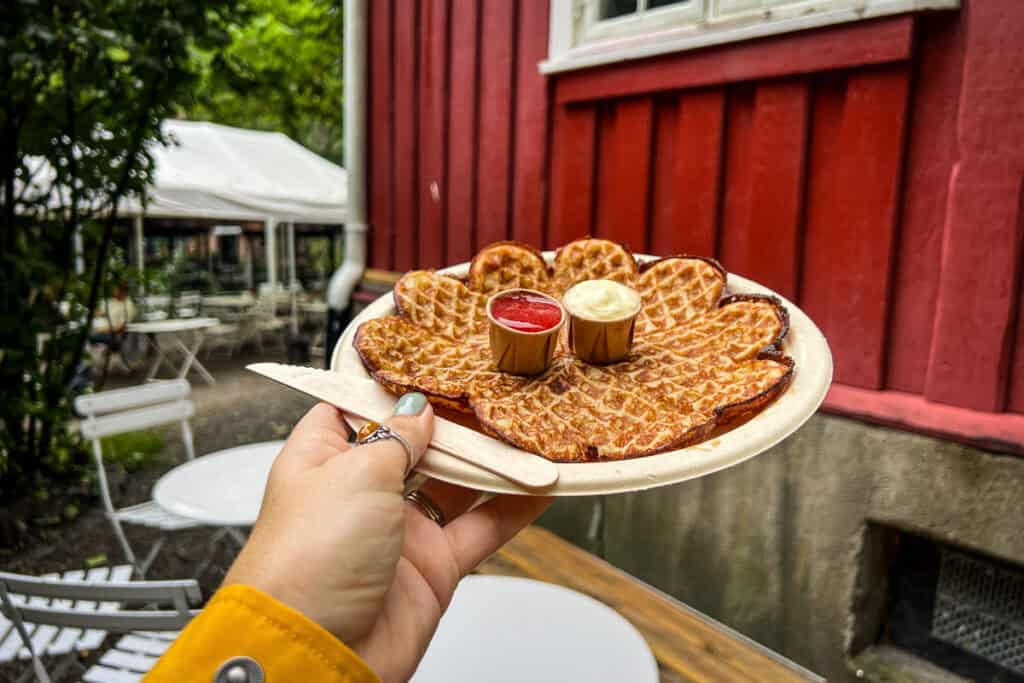
With only 2 days in Oslo, you’ll just be able to scratch the surface of the city’s foodie scene.
We’ve included our suggestions for places that are worth visiting in this itinerary.
- Bonita Cafe: cozy breakfast spot with healthy smoothie bowls and omelets
- Mathallen: large indoor market with a variety of international cuisines to choose from
- Hønse-Lovisas House: fairytale cafe above a waterfall with waffles and other treats
- Latter: unique dinner venue with live comedy and excellent food
- Pust: great coffee and pastries
- SALT: buzzy venue with live music and food carts
- Oslo Street Food: open market with 16 stalls offering a variety of international fare
- Frognerseteren: scenic restaurant overlooking the city
However, if you find yourself in the city longer than 48 hours, or you want some more options to choose from, here’s our list of restaurants we personally have saved to our own list that look great!
More ideas for places to eat
- Nedre Foss Gård: refurbished 19th century farm building that is now an atmospheric restaurant with a menu that changes with the seasons. This was recommended to us as a good lunch/brunch spot.
- Haralds Vaffel: hidden gem serving traditional Norwegian waffles
- Mamma Pizza: Italian restaurant that receives great reviews for food and service
- San Francisco Bread Bowl: hearty bread bowls with your choice of filling. They also offer beer flights.
- Seaport Restaurant – Sørenga/Bjørvika: waterfront dining with a focus on seafood
- The Salmon: sushi and other seafood options with indoor and outdoor seating on the waterfront
- Rorbua Aker Brygge: traditional Norwegian dishes next to the harbor
- Barcode Street Food: food court with a variety of options ranging in price
- Fiskeriet Youngstorget: highly-rated fresh seafood restaurant and fishmonger
- Indian Street Food & Co: beautifully-presented Indian dishes; the food here gets rave reviews
- Olivia Aker Brygge: upscale Italian restaurant on the waterfront
- Vippa: casual waterfront food court
Insider Tip: Our personal motto on eating in Norway was to do a bit of research before choosing a restaurant because it ain’t cheap to eat out in this country! When you’re paying $20 for a casual meal from a food truck or $30-40 for an entree in a casual restaurant, you want to make sure it’s going to be worth your money. We hope that all the time we put into researching where to eat in Oslo will be helpful to you!
Where to stay in Oslo
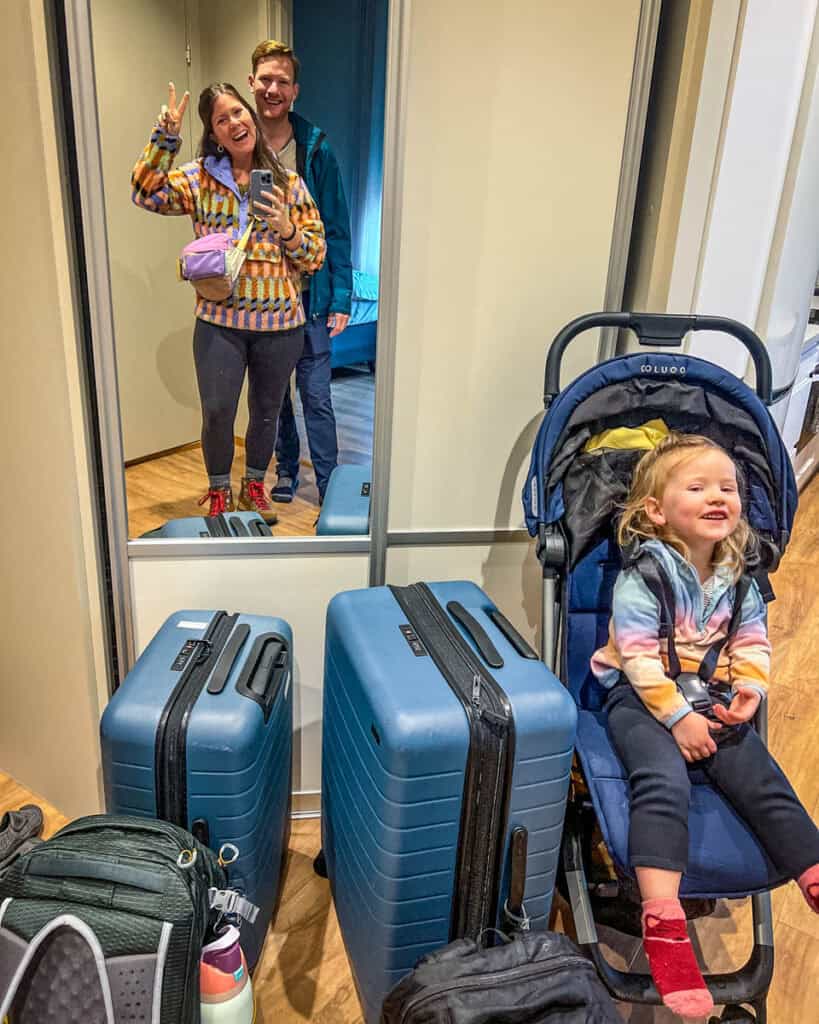
There are lots of great places to stay in Oslo. We’re sharing our top recommendations, as well as one hotel we would avoid…
Luxury Apartment with a great location (our top Airbnb pick)
- 2-bedroom Airbnb
- great for a family
- great location in the city center (near Munch museum and Opera House)
- 2-night minimum
- rave reviews
Modern Condo in city center
- 2-bedroom Airbnb
- great for a family
- great location, walking distance to popular sights
- 2-night minimum
- highly rated
Sleek hotel with excellent breakfast
- great location
- free breakfast with rave reviews
- no minimum stay
Good value hotel in city center (basic budget option)
- self-serve check-in & check-out
- close to Oslo Central Station
- no minimum stay
Splurge-worthy B&B
- stunning baroque decor
- excellent breakfast included
- no minimum stay
- rave reviews
Hotel to avoid…
We had a pretty bad experience with the accommodation we booked in Oslo, so we’re sharing the property here so you don’t make the same mistake!
This listing shows beautiful photos, but when we arrived, it was a totally different unit.
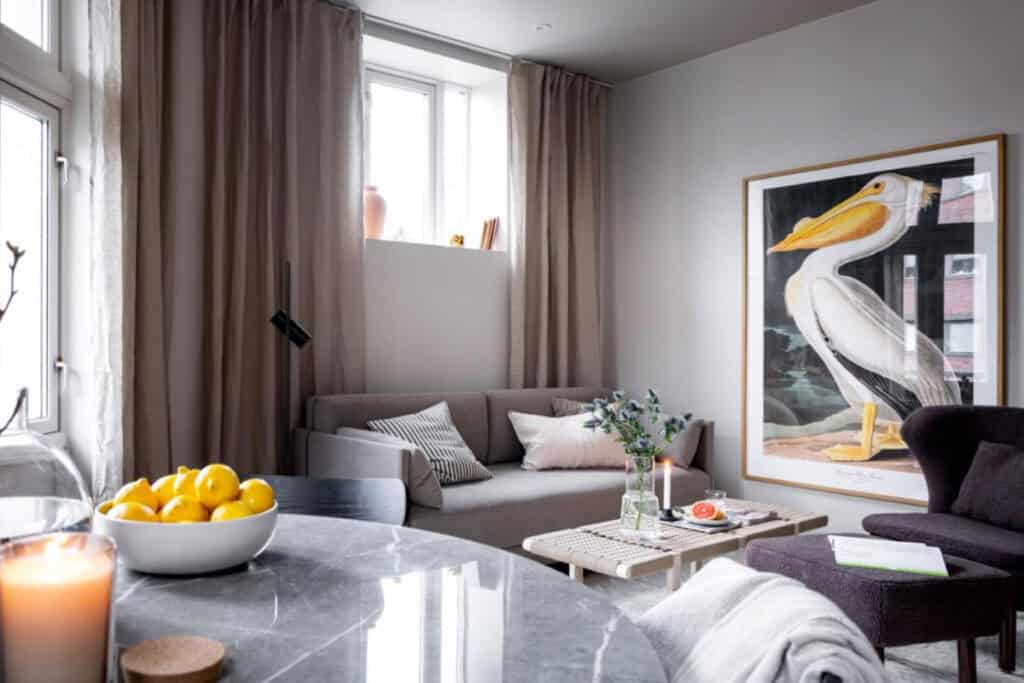
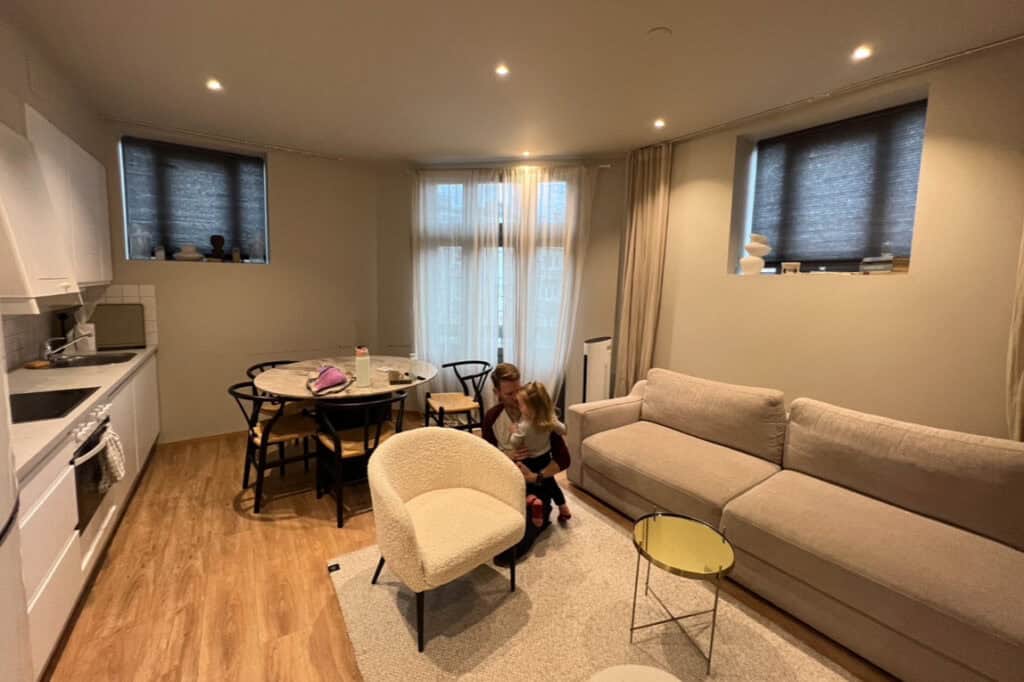
It was a similar layout, but the bed and bedroom were much smaller (and not nearly as nice). The shower was significantly smaller and the kitchen was not the newly renovated one in the photos. Additionally, there were amenities listed, like shampoo and body wash, that were not provided. I’m not sure why the other reviewers did not mention this.
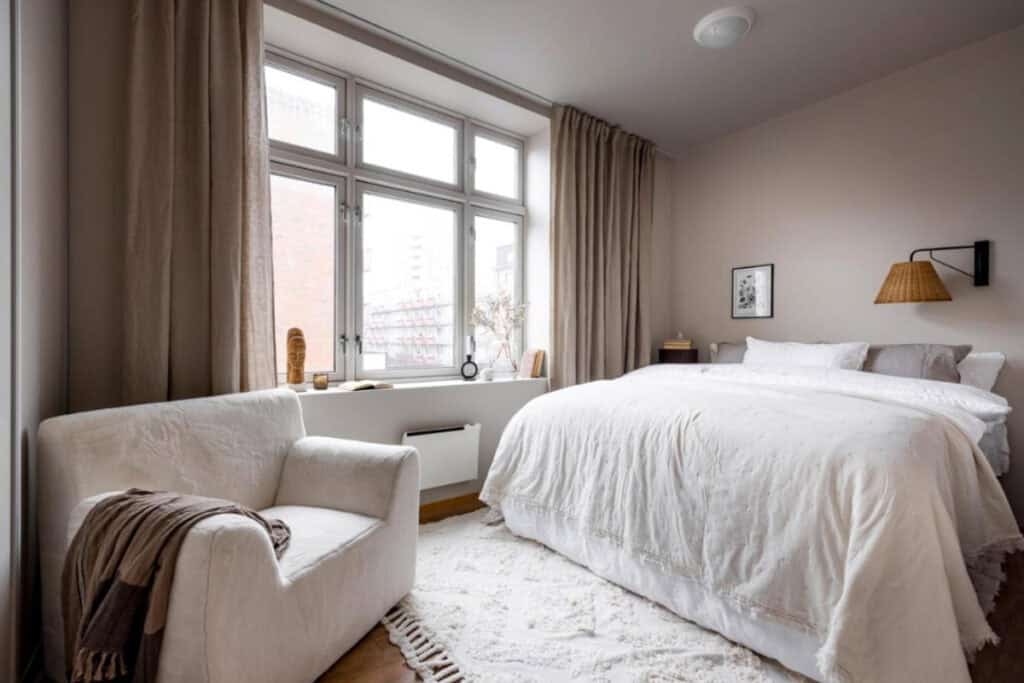
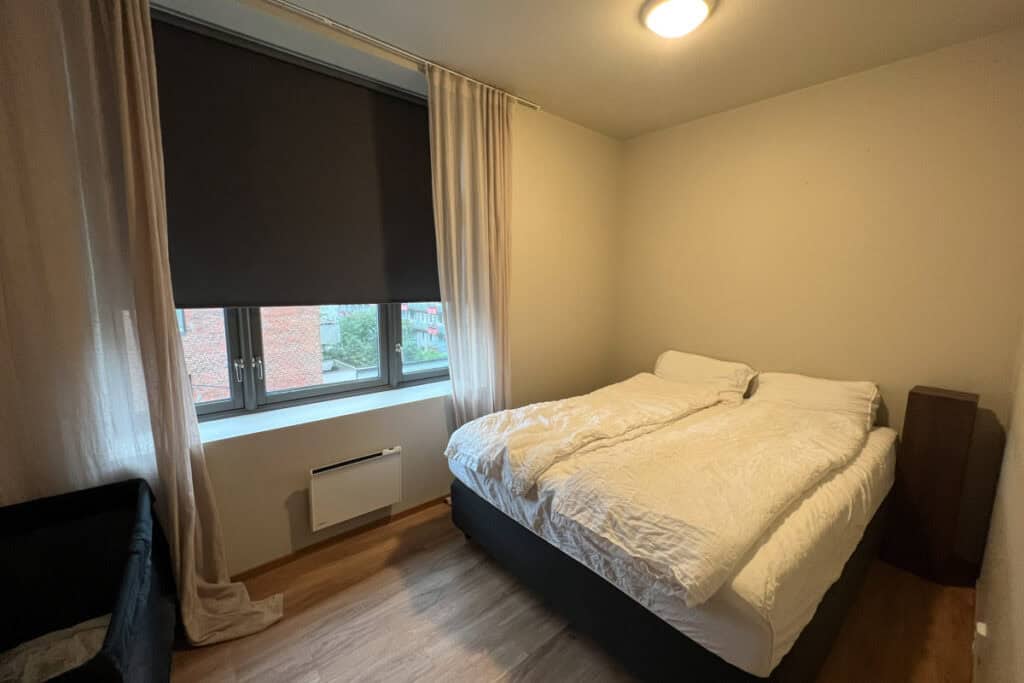
To be clear, we DO NOT recommend this property. We’re simply sharing it here so you don’t get tricked by the pretty pictures like we did.
Oslo Pass
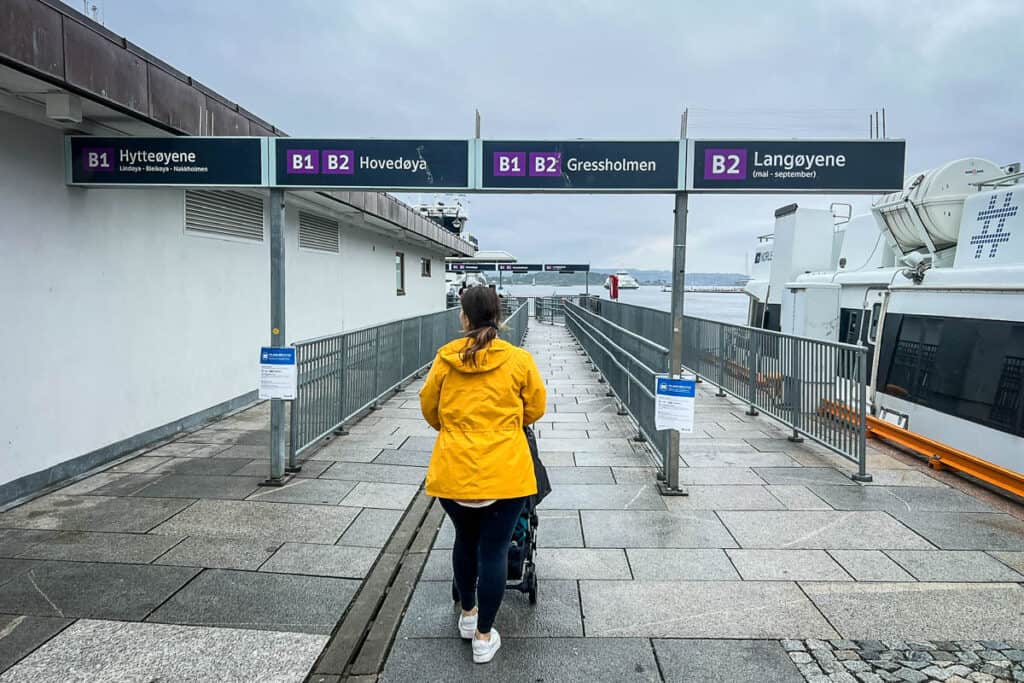
As you’re researching your trip to Oslo, you’ll likely come across the Oslo Pass and find yourself wondering what exactly it includes and whether it is worth it for your trip.
We’ve answered both questions for you:
What does the Oslo Pass include?
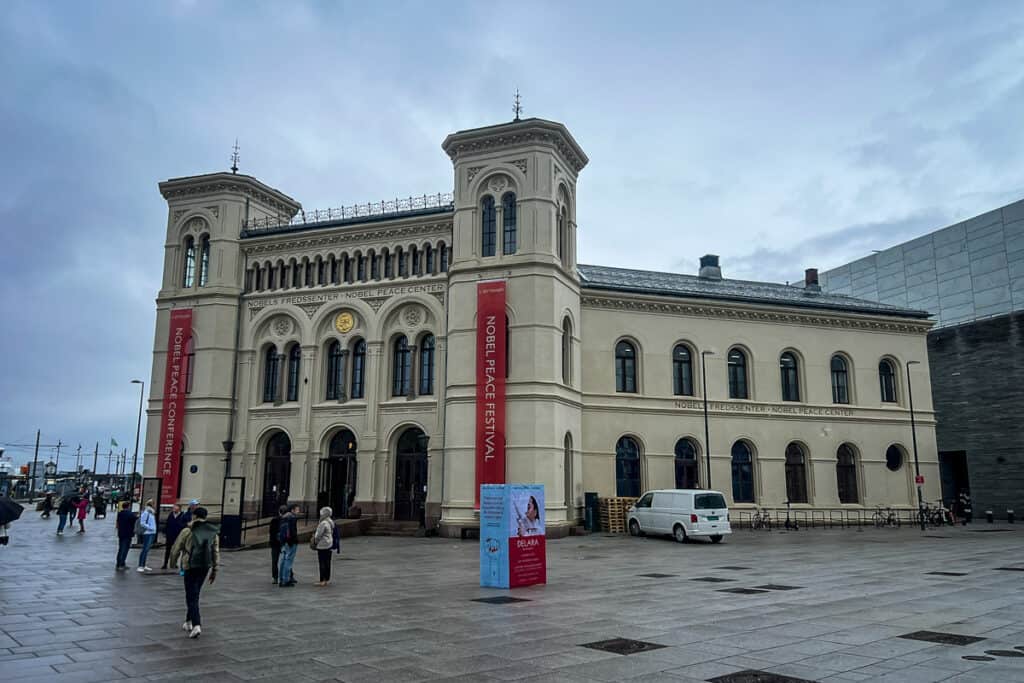
In short, this pass gives you free admission to 30 museums and attractions (emphasis on the museums!). It also gives you unlimited free public transportation.
Here is a list of all of the included attractions.
Oslo Pass prices 2024
Adult
- 24-hour pass: NOK 520 ($49)
- 48-hour pass: NOK 760 ($72)
- 72-hour pass: NOK 895 ($85)
Child (6-17 years old)
- 24-hour pass: NOK 260 ($25)
- 48-hour pass: NOK 380 ($36)
- 72-hour pass: NOK 450 ($43)
Senior (67 years+)
- 24-hour pass: NOK 415 ($39)
- 48-hour pass: NOK 605 ($57)
- 72-hour pass: NOK 720 ($68)
Note: Conversions are estimated at the time of publishing. Pass prices may change from year to year. See this website for current pricing and how to purchase the Oslo Pass.
Is the Oslo Pass worth it?
We personally did not purchase the pass because we chose to only visit one museum during our 48 hours in Oslo. There were just too many other things we wanted to see and do!
That said, if you are interested in visiting several museums, it can make a lot of sense.
How to get around Oslo
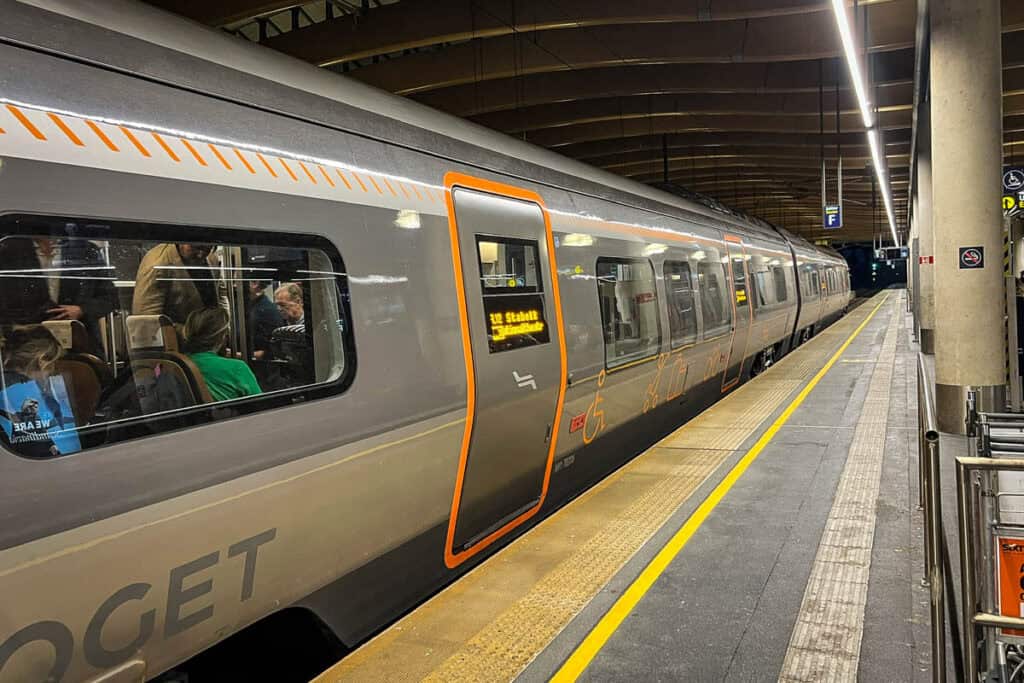
Oslo is really well-connected with public transportation, including the subway, buses, and trams.
Outside of Oslo, we recommend renting a car (or campervan), but while you’re in the city, there’s no need for a vehicle since you can get everywhere you need to via public transportation.
You can purchase public transportation passes on the Ruter App. Depending on how many buses, trams, and subways you use, it can save money. In addition to potentially saving money, it is so much more convenient to have a pass instead of having to purchase an individual ticket each time you get on public transport.
- 24-hour ticket: NOK 127 ($12)
- Single ride ticket: NOK 42 ($4)
The only other options are 7-day, 1-month, and year-long passes.
Rule of thumb: After doing the math, it makes sense to purchase a 24-hour ticket if you plan to ride any form of public transportation 3 times or more. Technically, if you only ride 3 times, the total cost will be NOK 126, which is roughly 10 cents less than the cost of a 24-hour pass. In that case, we personally think the convenience of not having to purchase individual tickets is worth 10 cents!
Our personal experience: We purchased two 24-hour passes to cover our time in Oslo.
Alternatively: If you plan to purchase the Oslo Pass (more on that above!), you don’t need to purchase a public transport pass since it is included.
How to get to Oslo from the airport
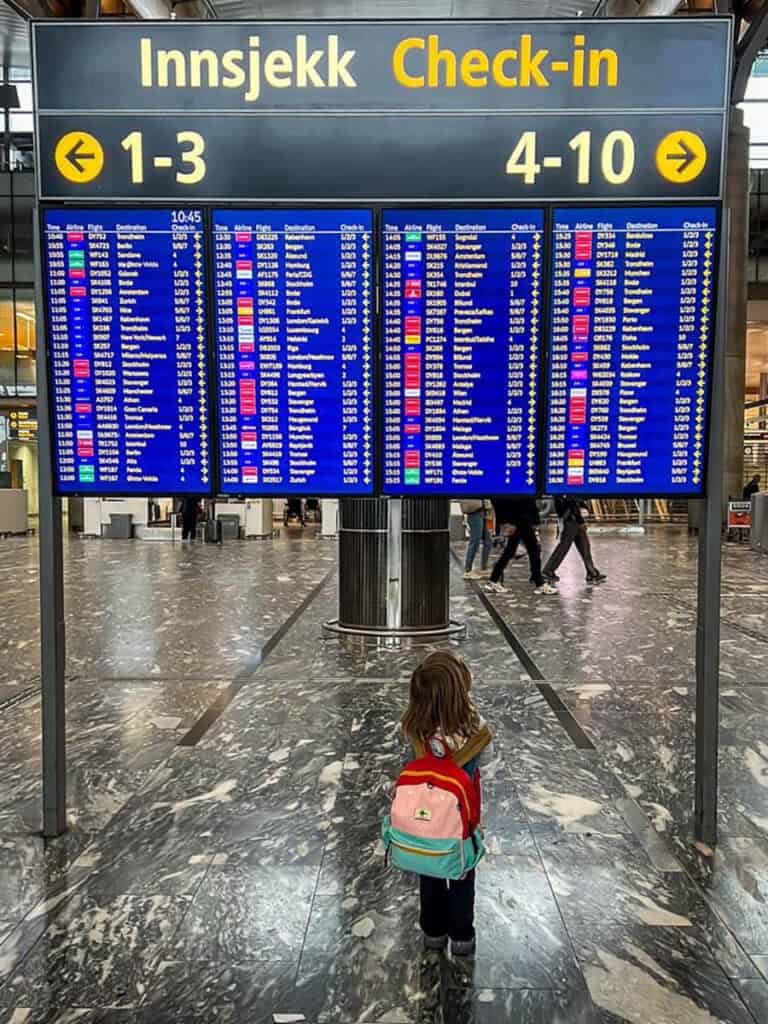
There are a few ways to get from Oslo Airport to the city. Our recommendation is to take the Flytoget Airport Express Train, which leaves every 10-20 minutes (depending on the time of day) and takes only about 20 minutes to reach Oslo Central Station. A single adult ticket is NOK 240 one-way ($22).
Alternatively, taking a bus or a local train would be a cheaper option. However, you may need to wait longer as they don’t depart as often, and the journey itself could also take longer.
We wouldn’t recommend taxis or Uber for most people because they are very expensive.
Planning a trip to Norway?
We have lots of resources on travel in Norway and destinations around the country. Check out our Norway Travel Homepage for everything you need to know, or start by reading some of our favorite Norway travel articles to help you plan your dream vacation.
- Norway Packing List: What to Wear + FREE Checklist!
- 1 Day in Bergen: Perfect 24-hour Itinerary You Can Steal!
- Best Cities to Visit in Europe
- Best Time to Visit Europe: When to Go & When to Avoid!
Be sure to download our ultimate packing list for Norway! It’s packed with good suggestions and insider tips to help plan your Norway trip. And it’s completely FREE, so why not!?
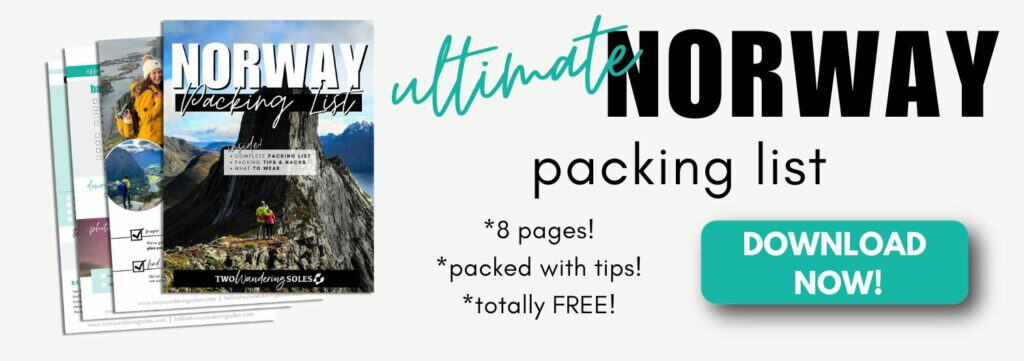
Save this itinerary on Pinterest for later!
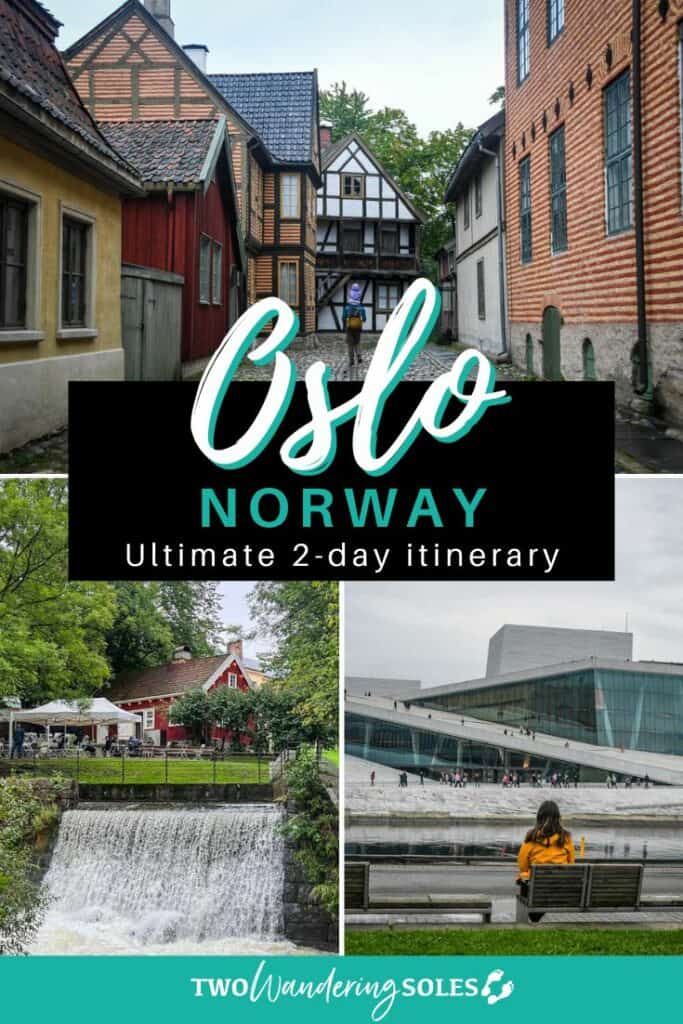
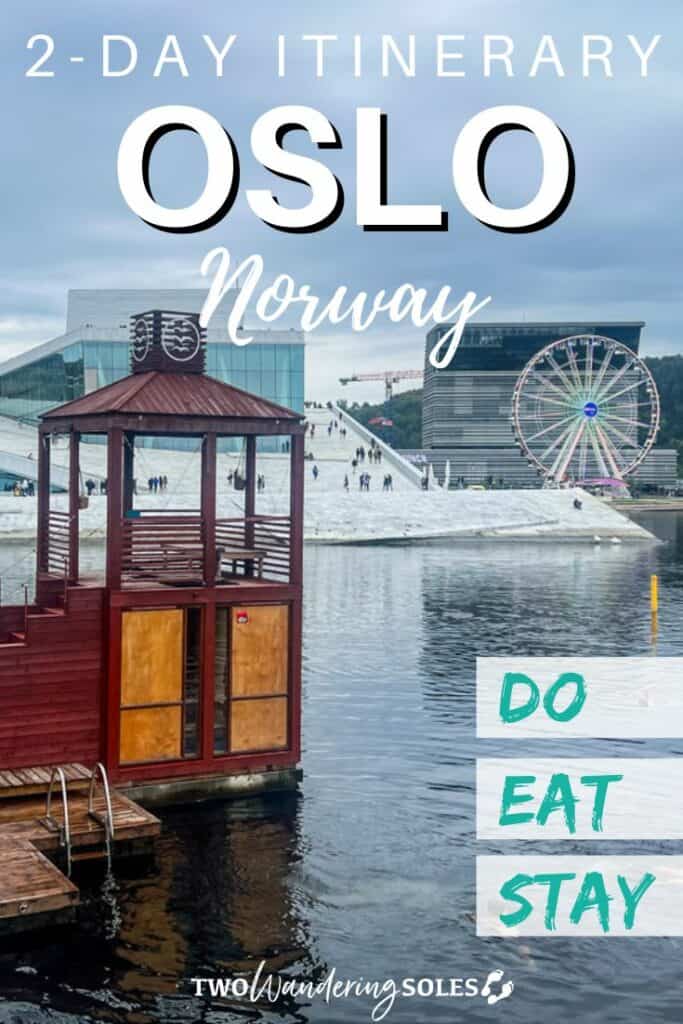
We want to hear from you!
What do you think about this itinerary for 2 days in Oslo? Are you planning a trip to Norway and have more questions? Let us know in the comments and we’ll do our best to get back to you!

